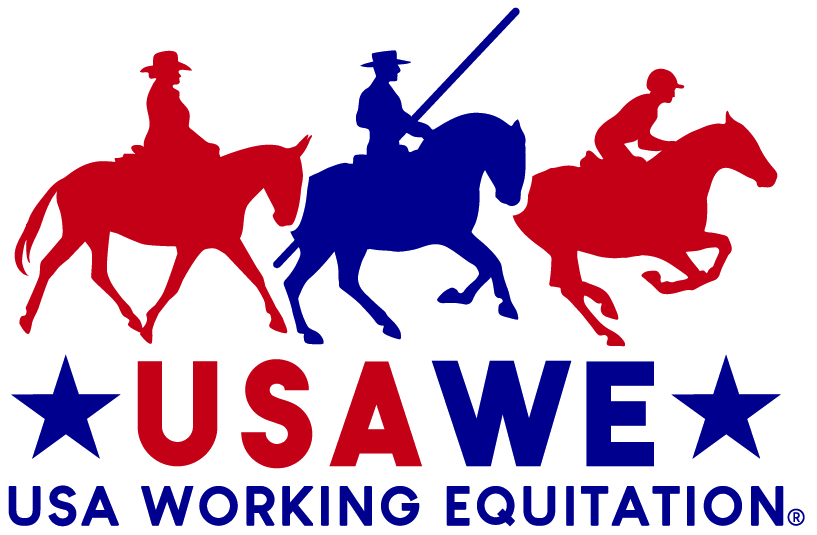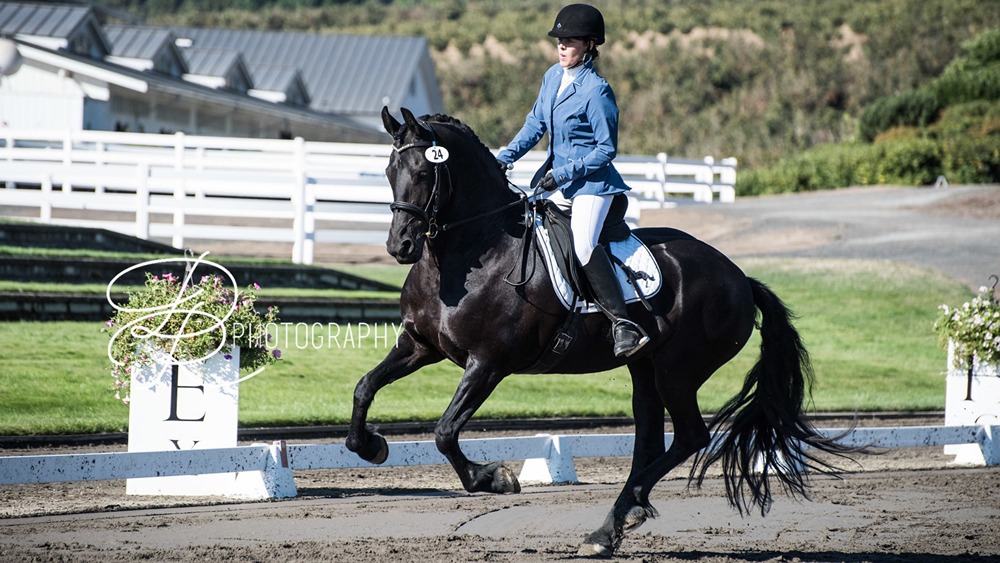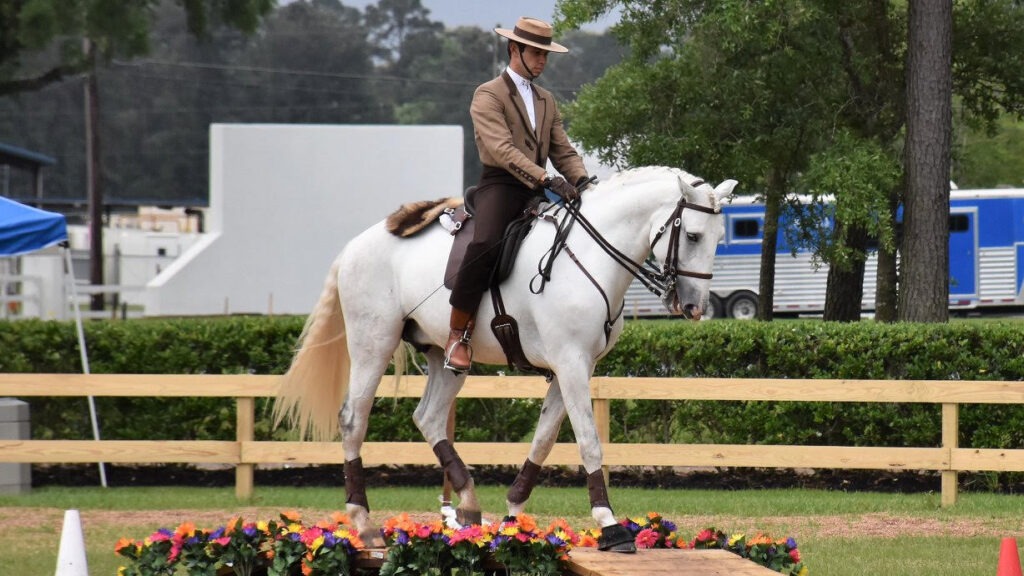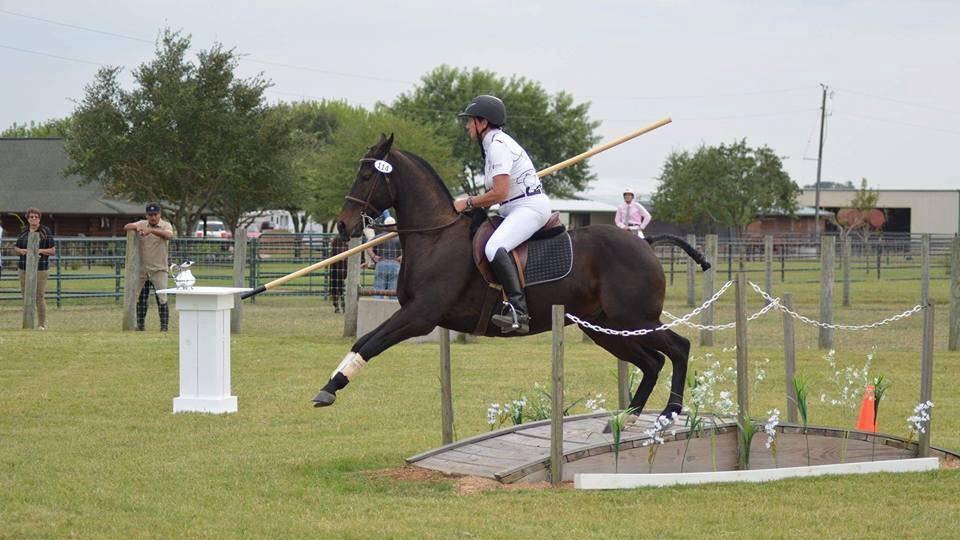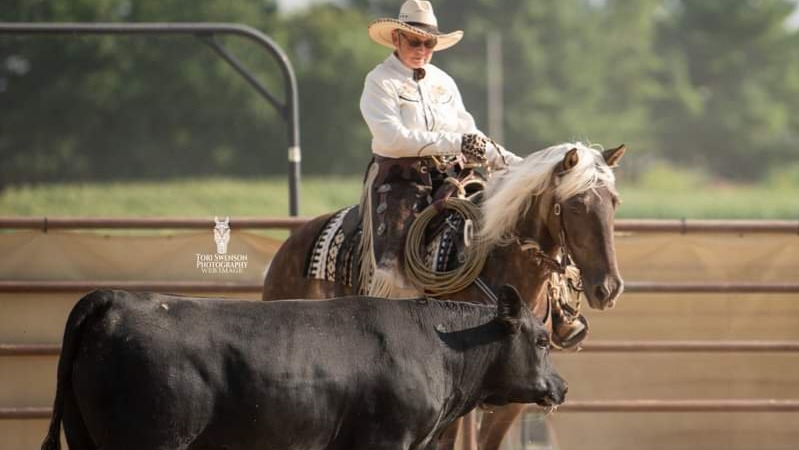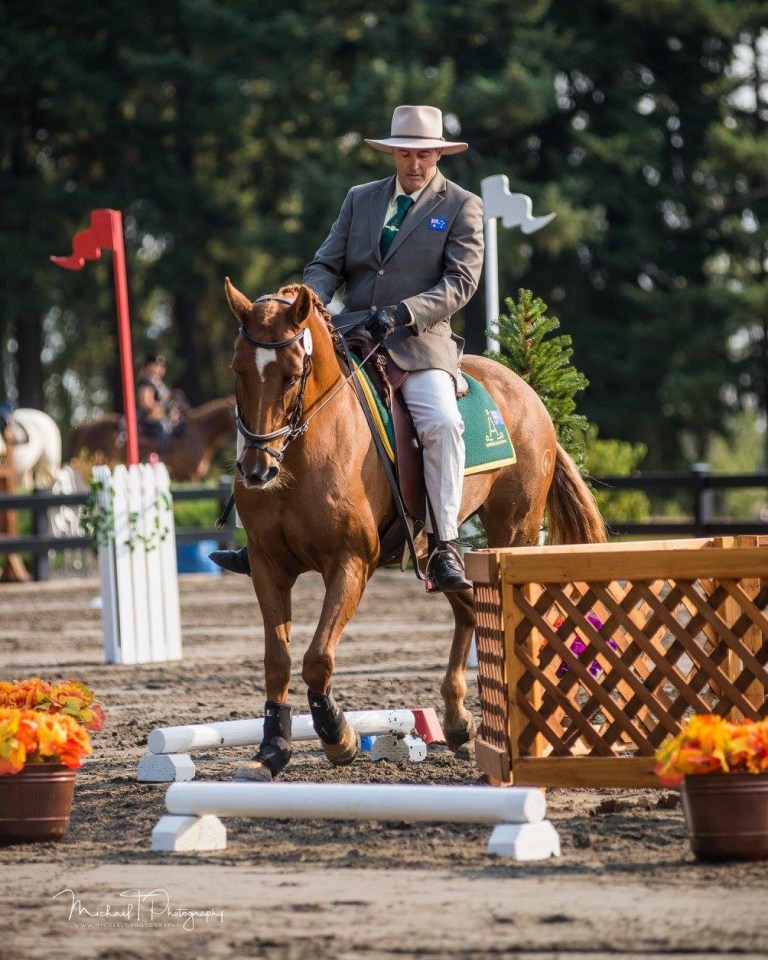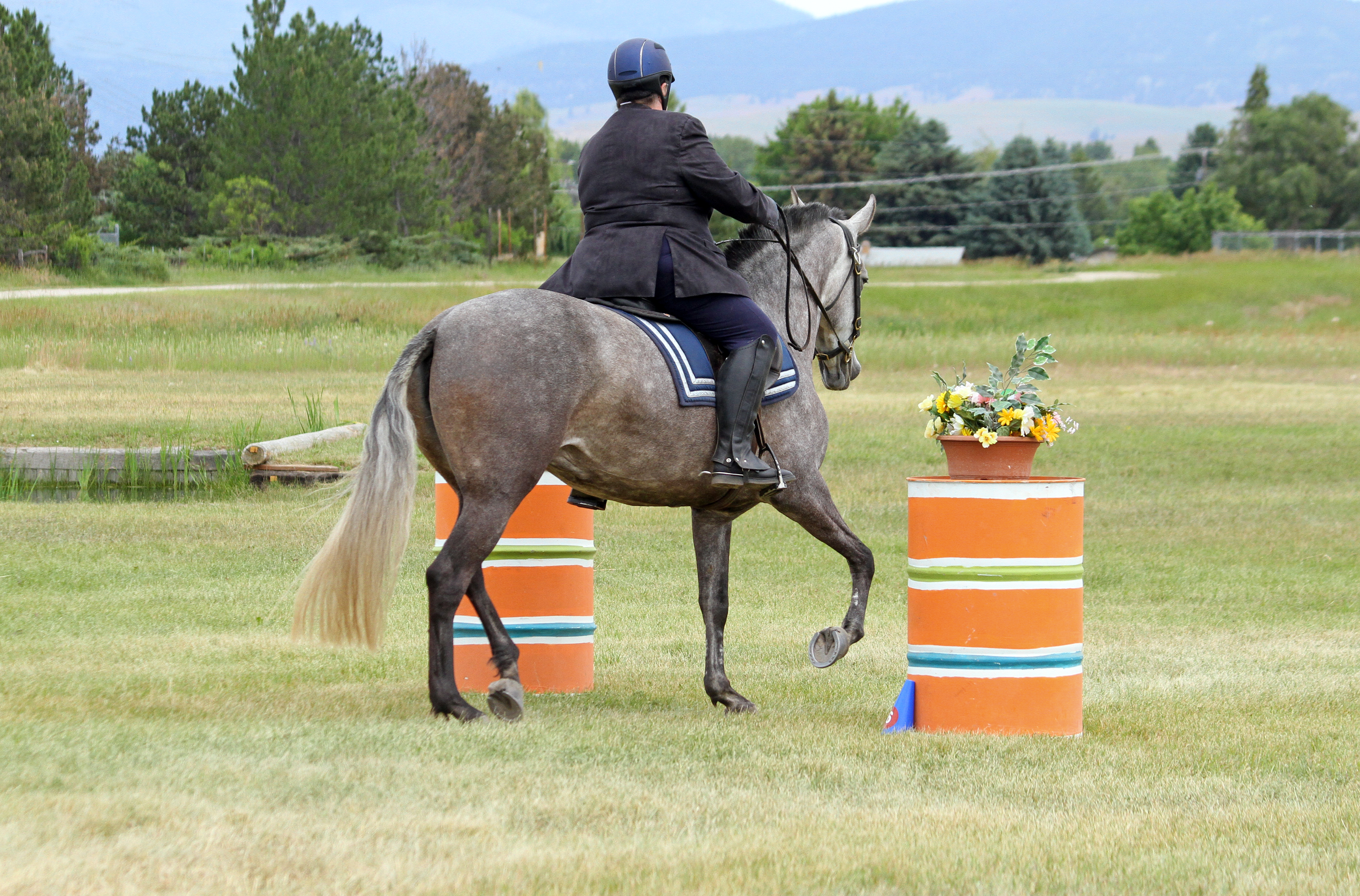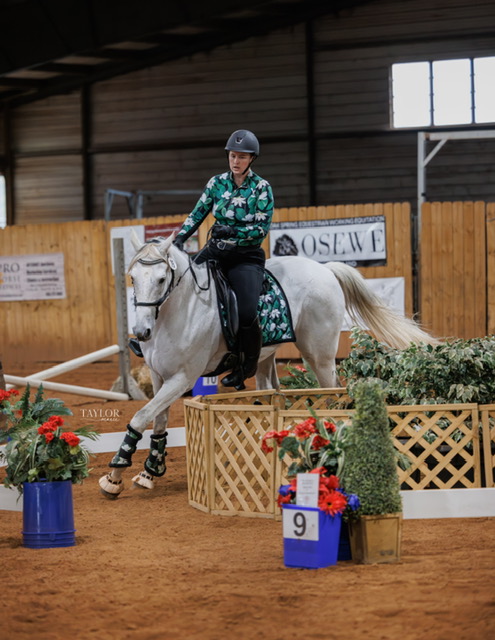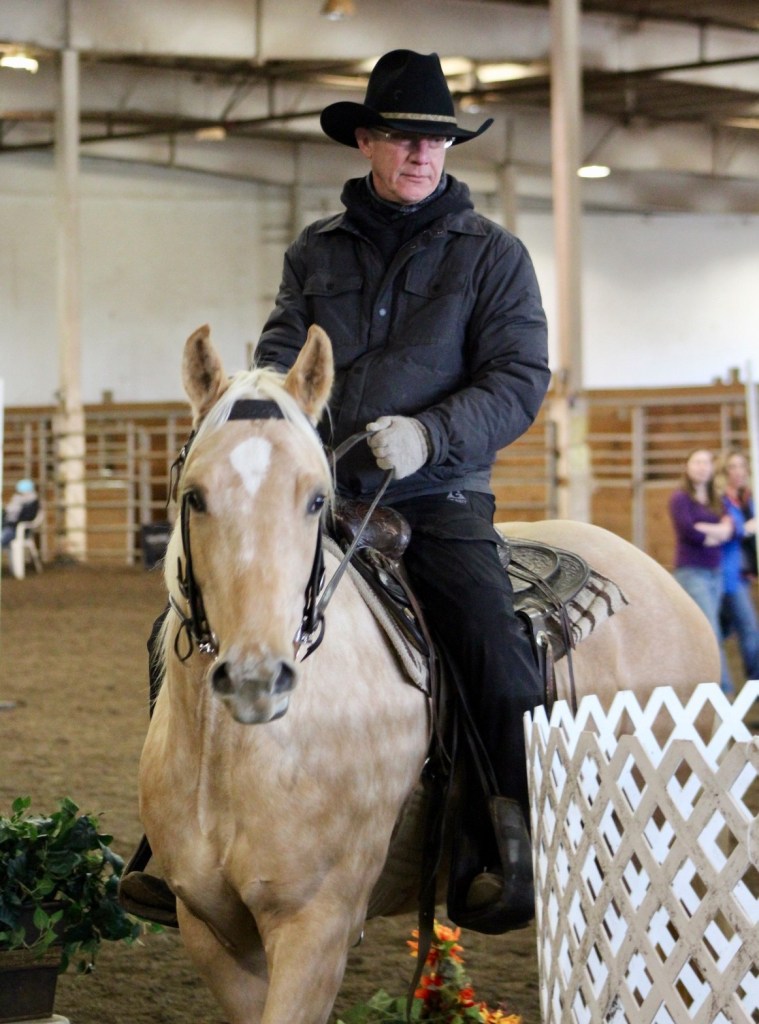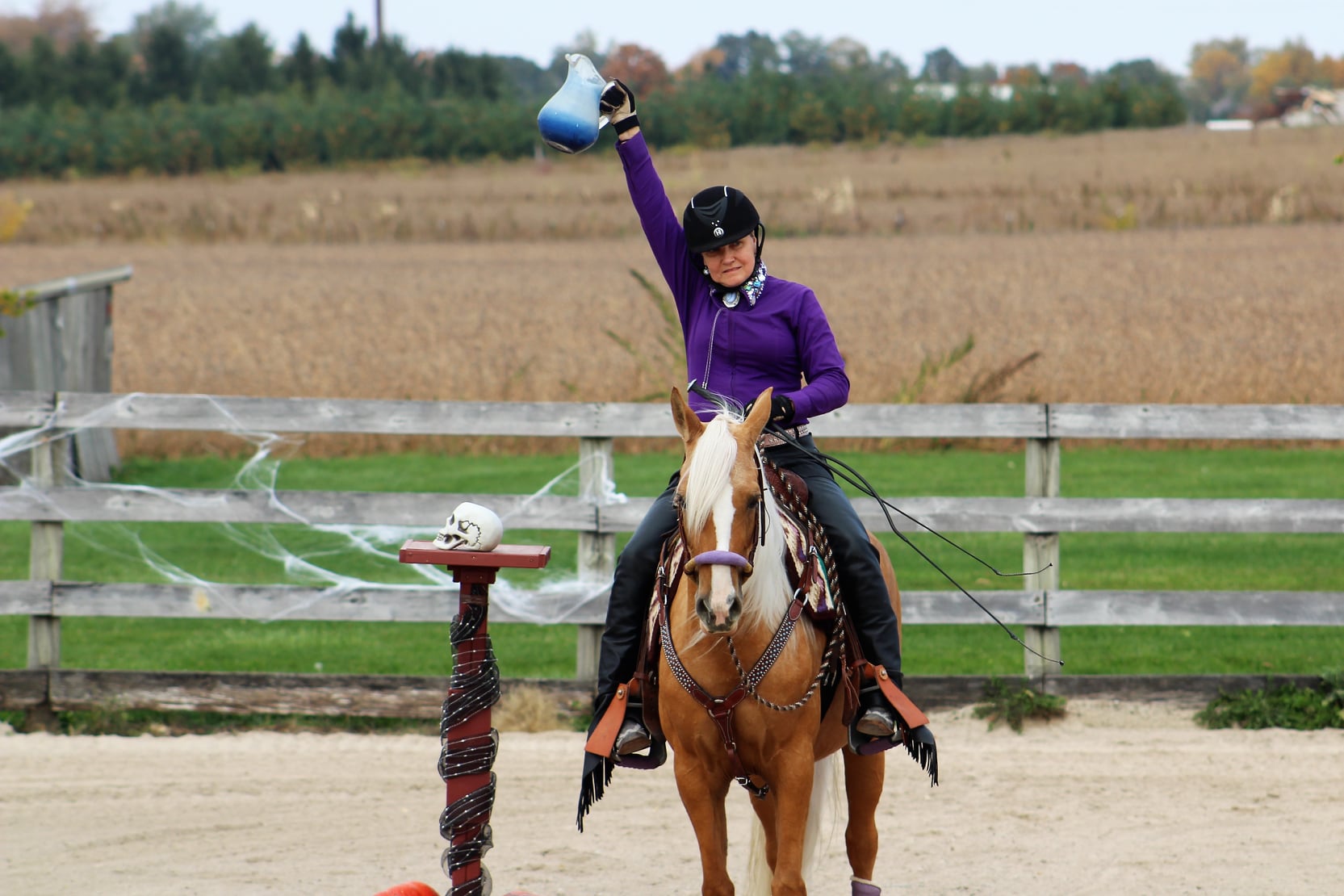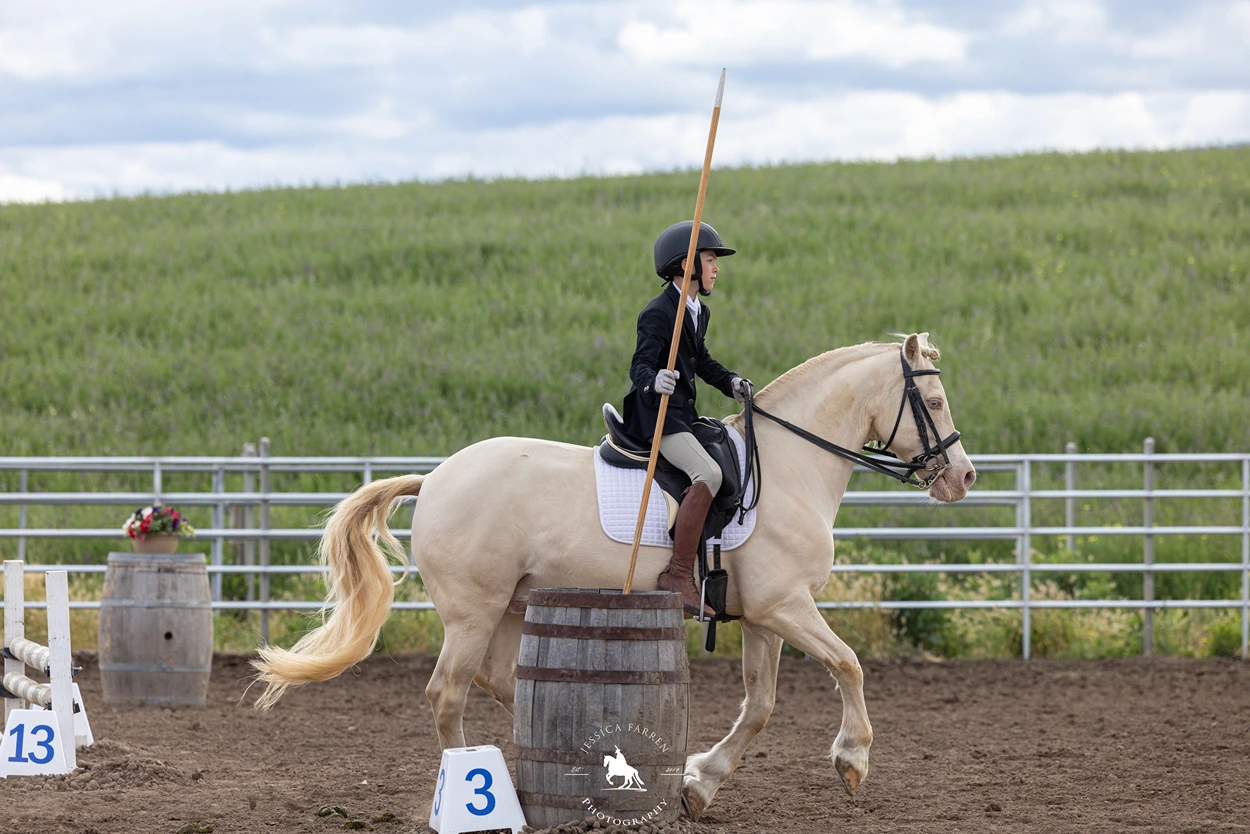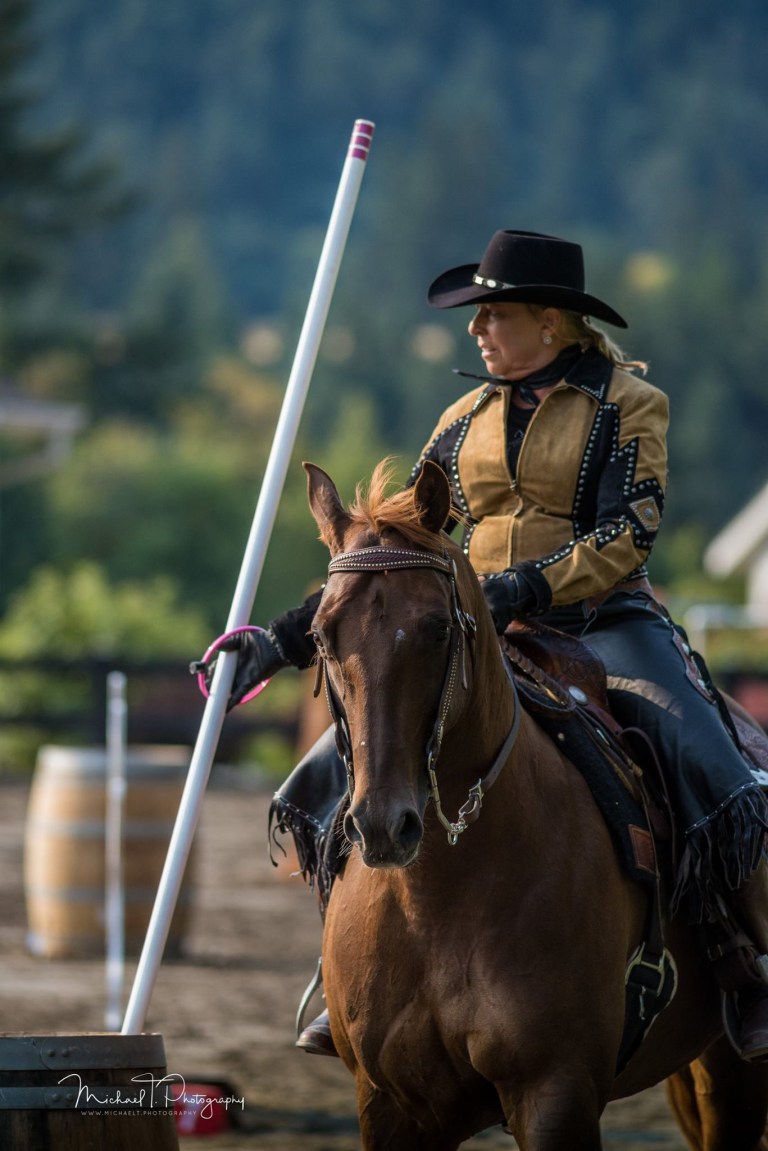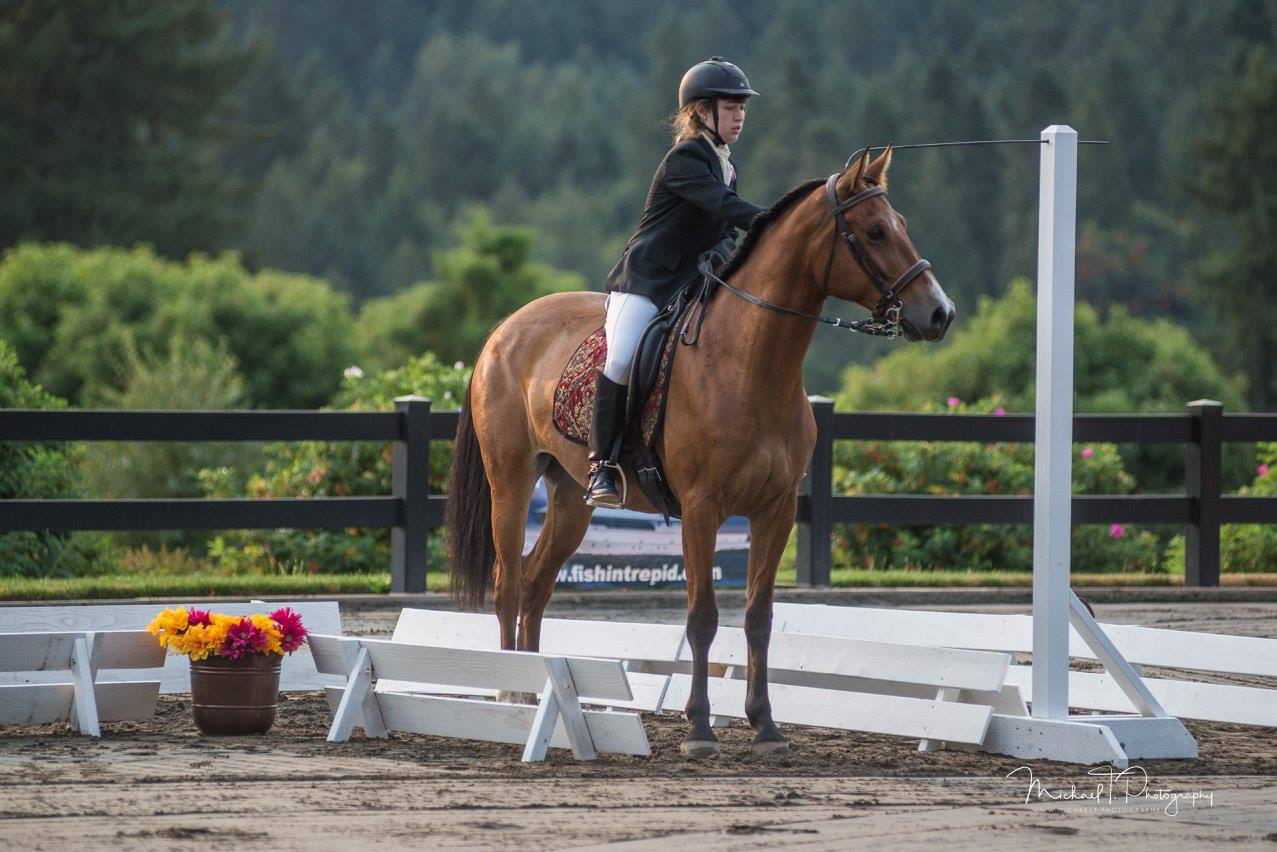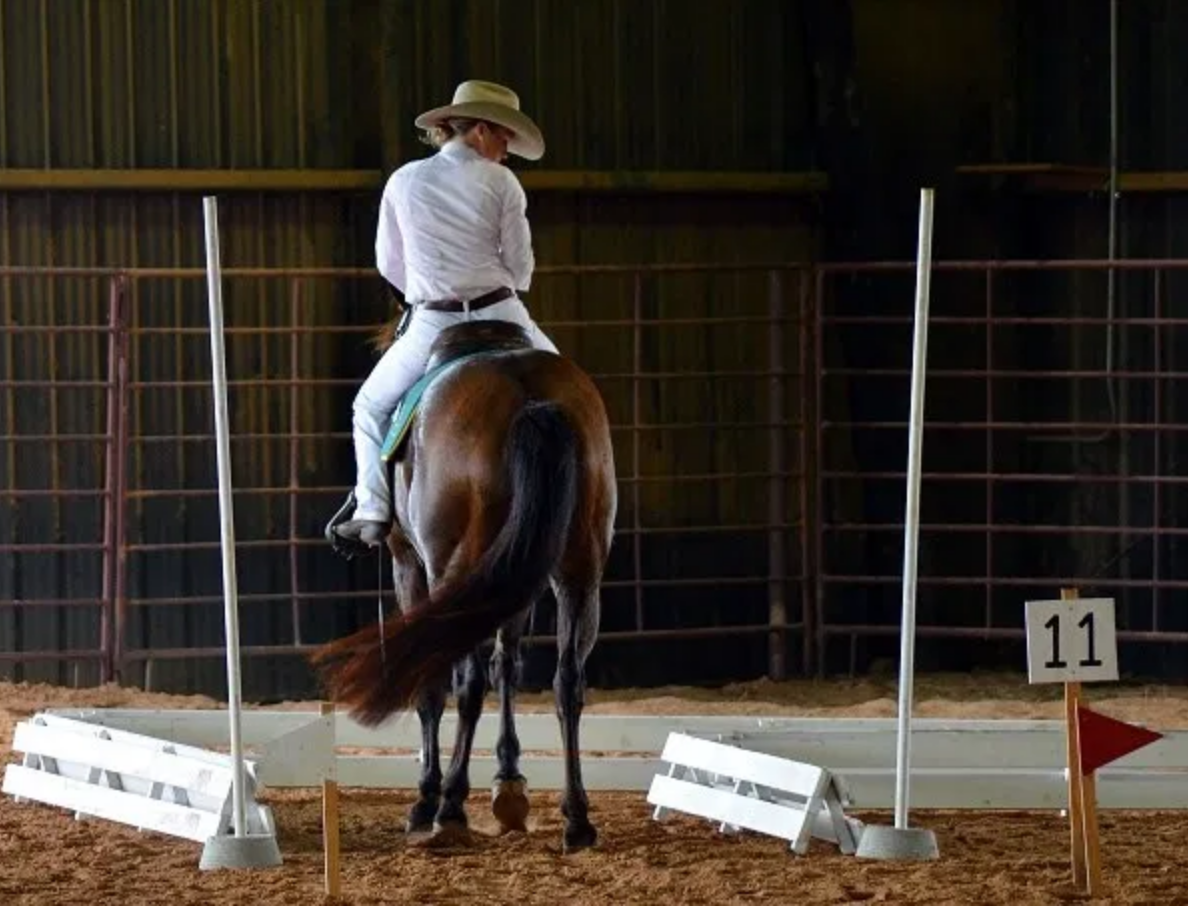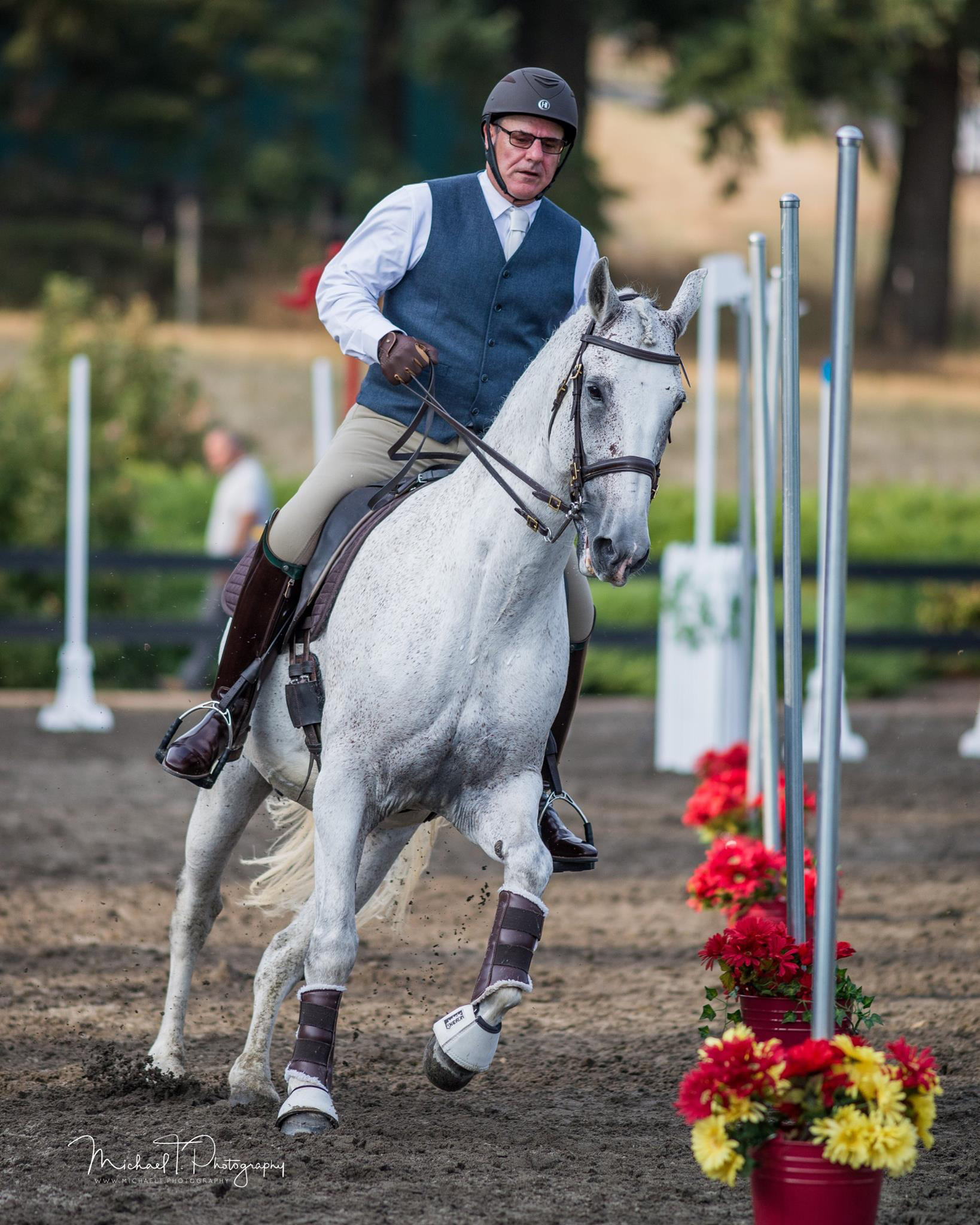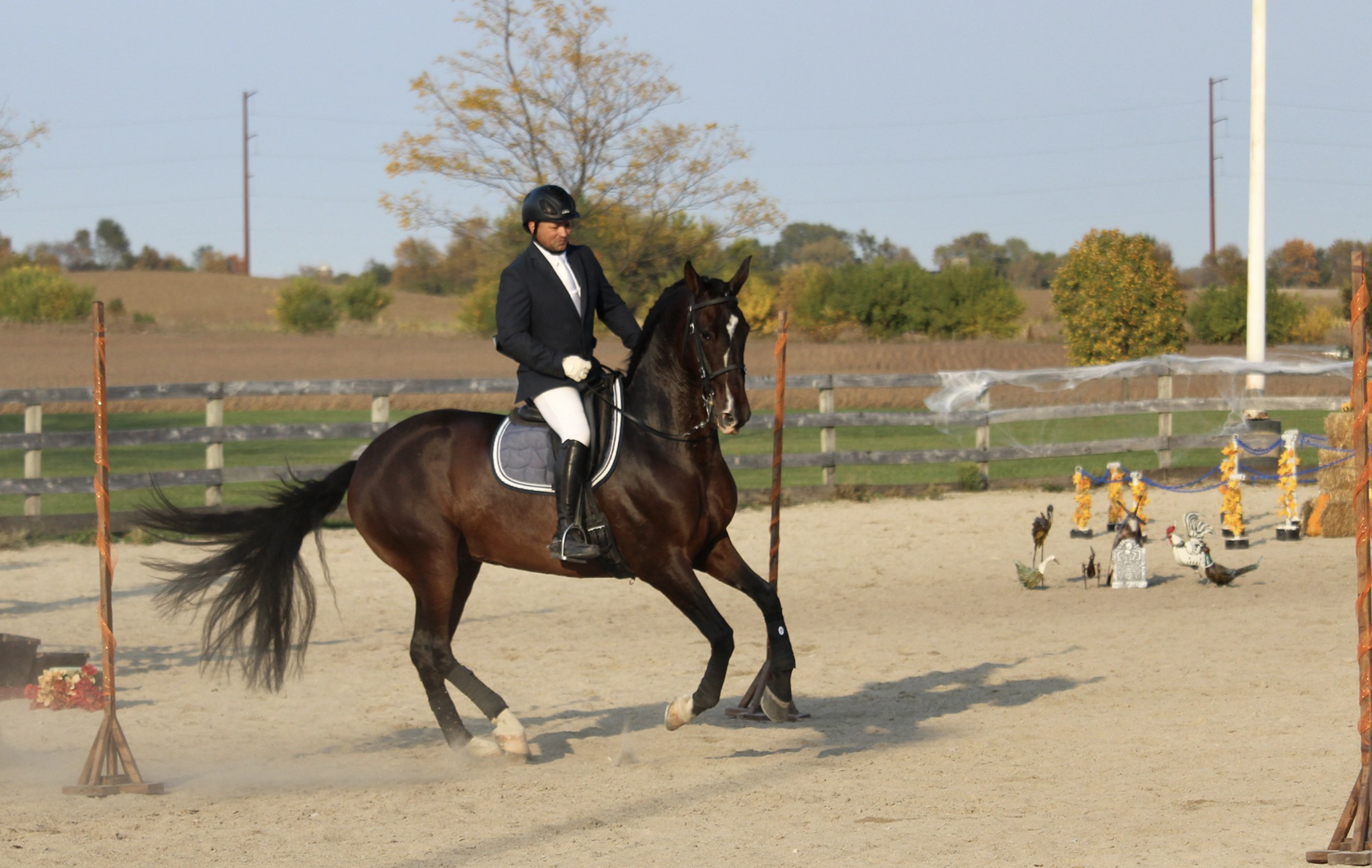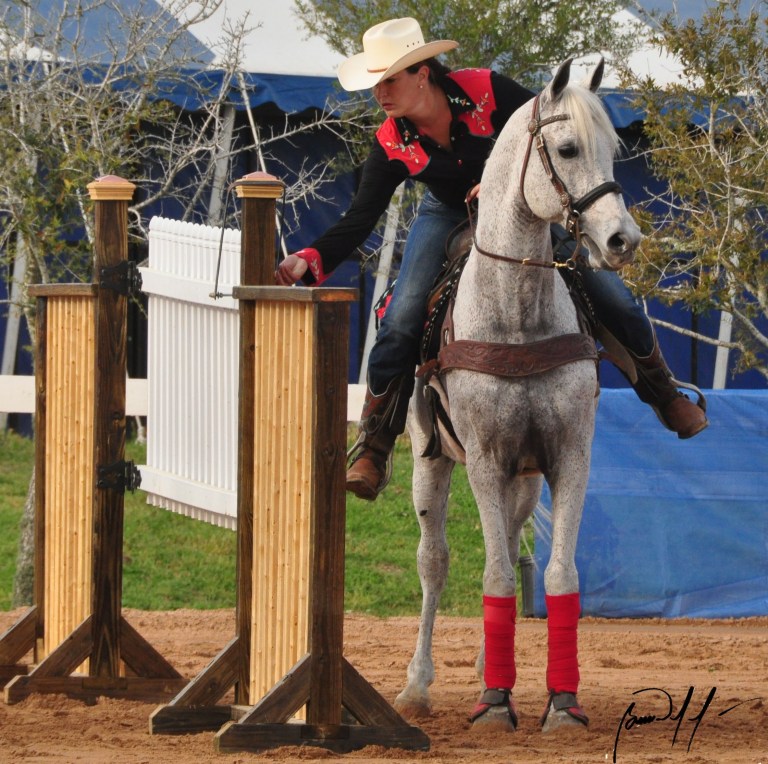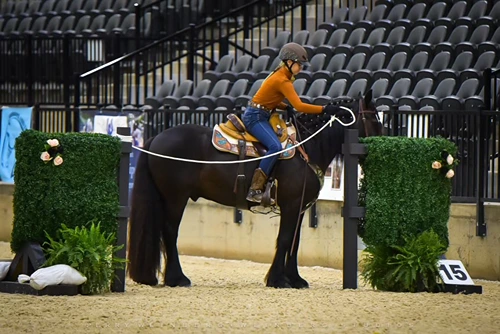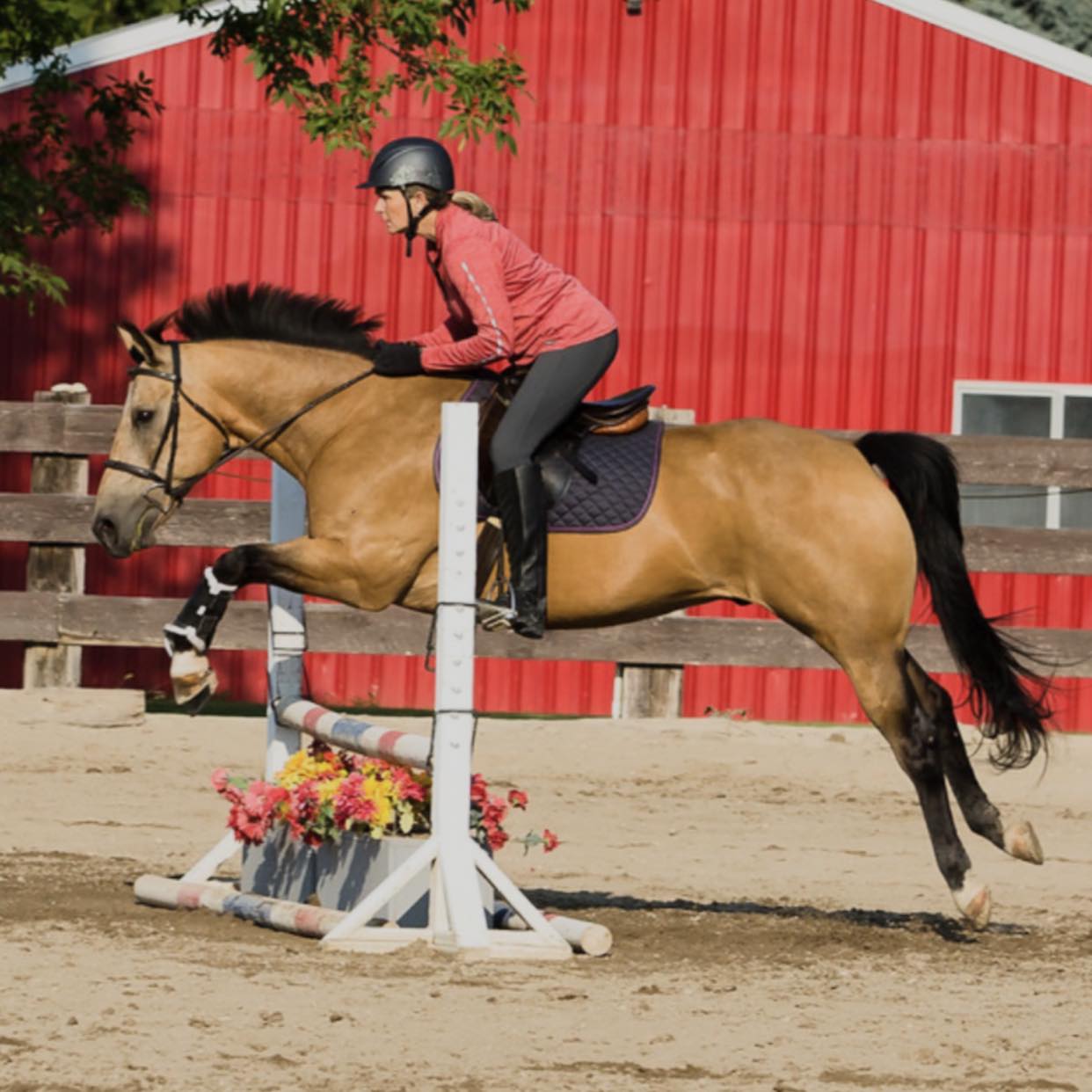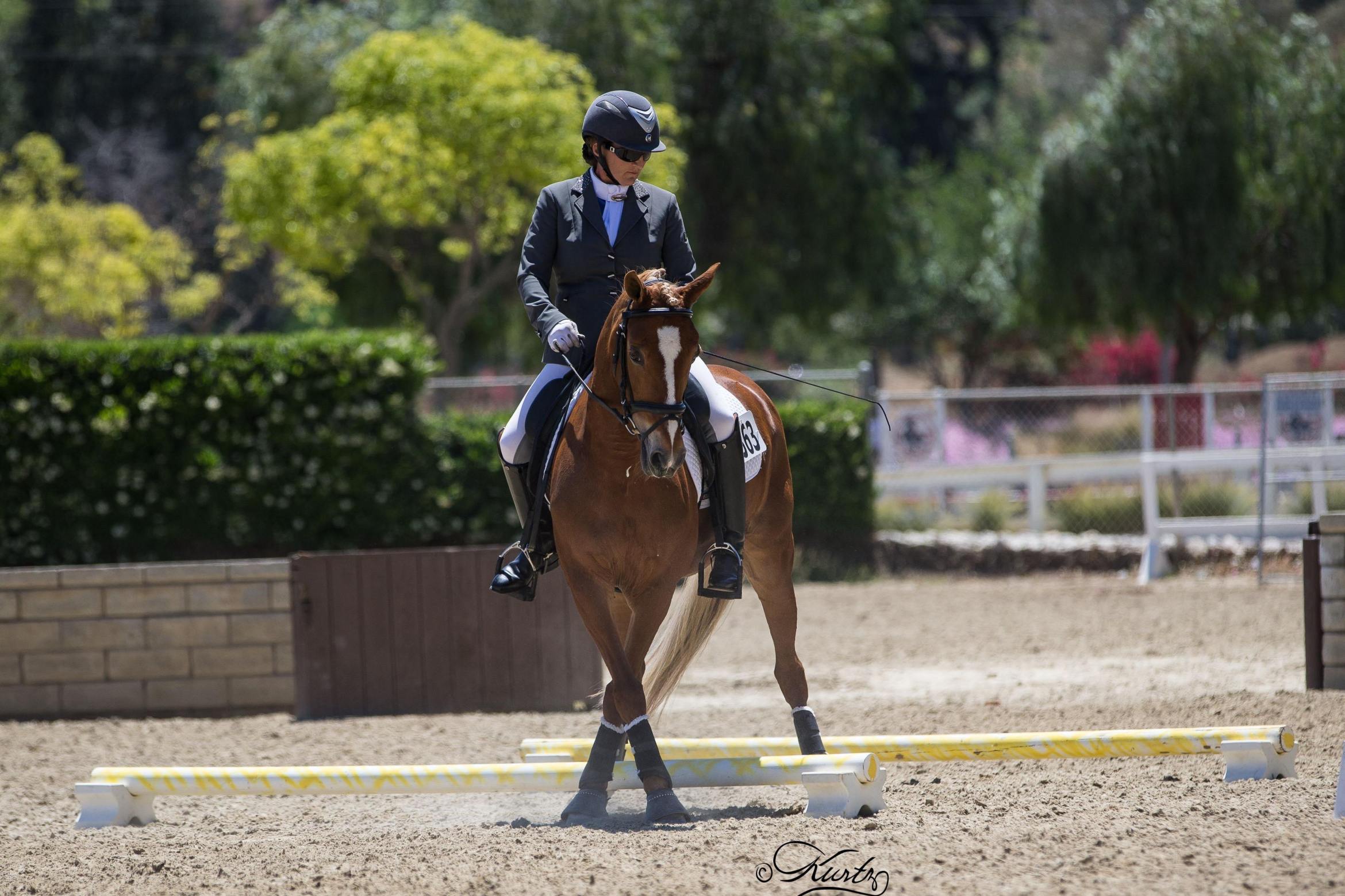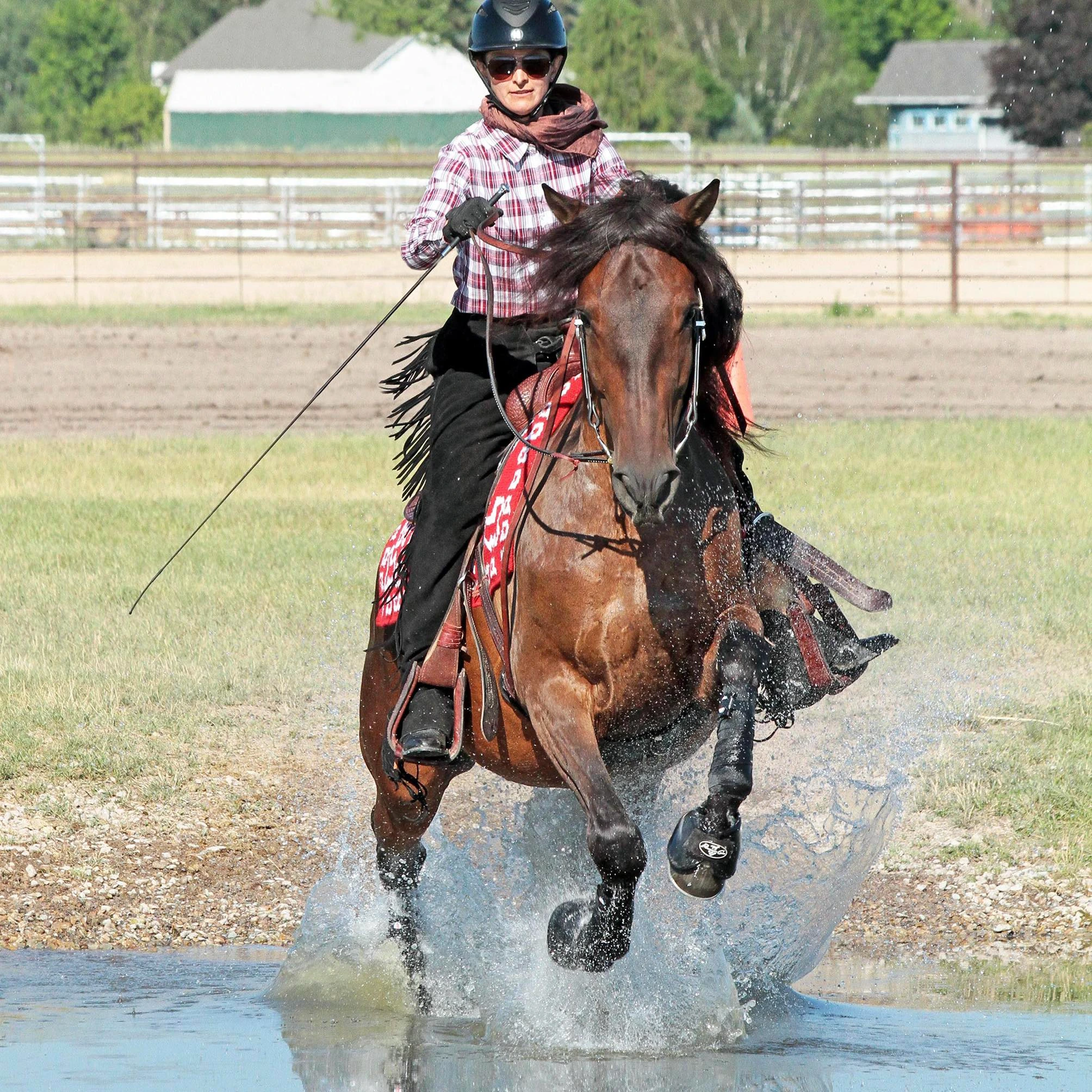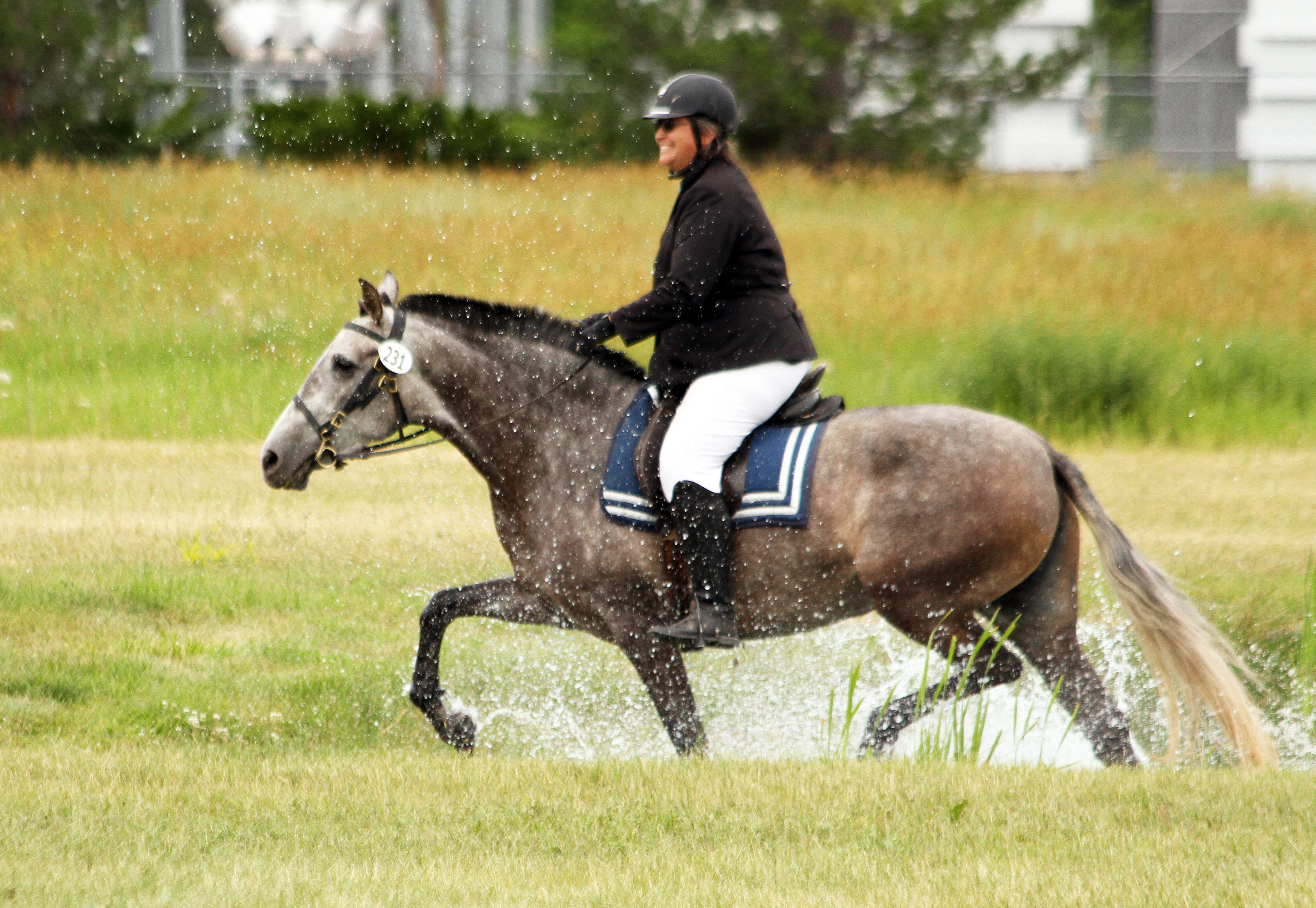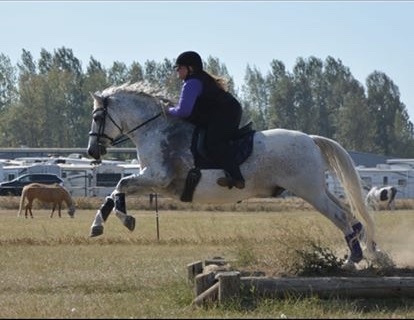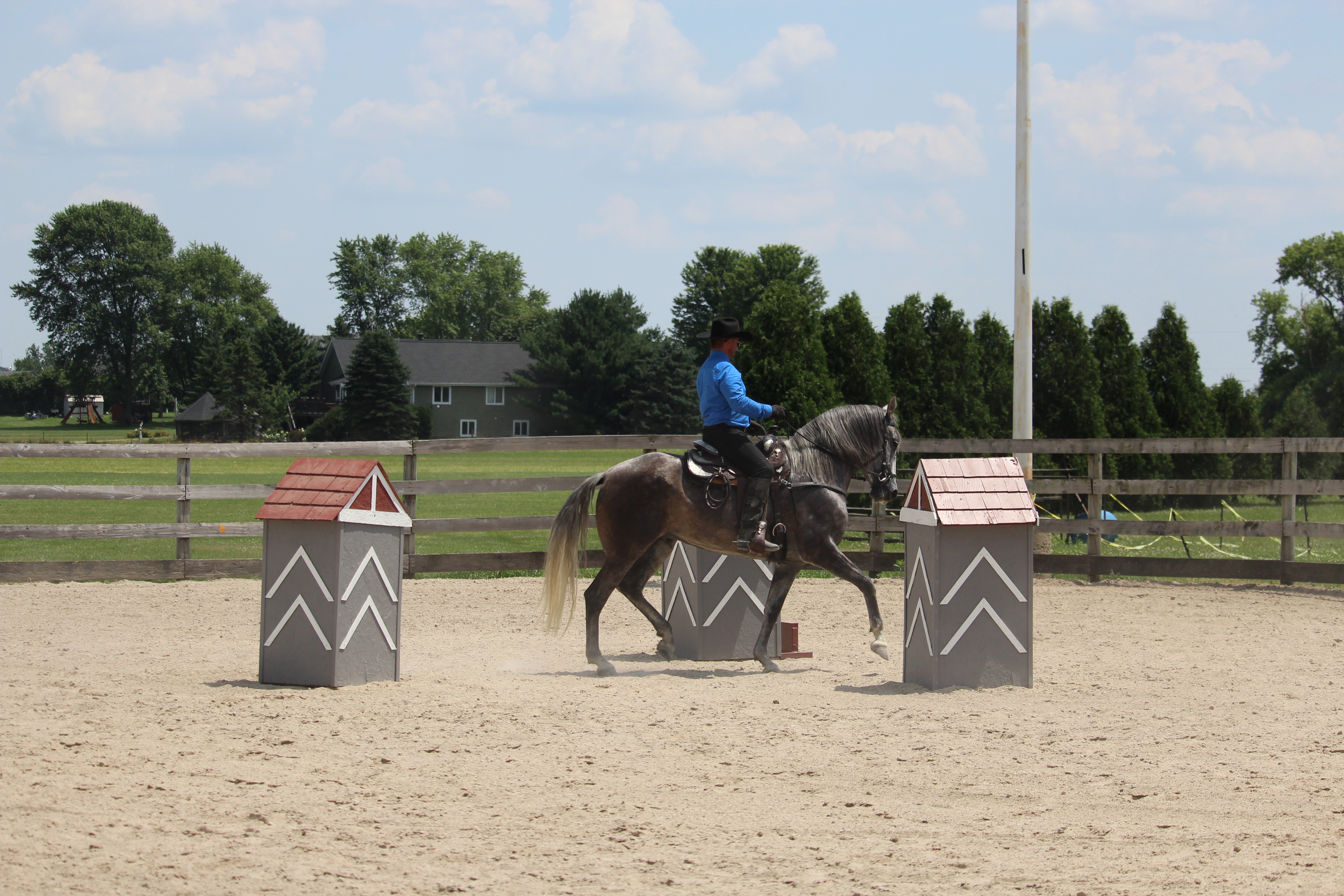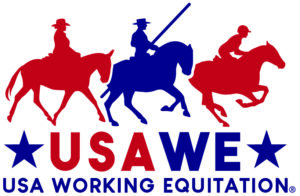Ease of Handling Trial
Ease of Handling Trial
Ease of Handling (EOH) is the second trial of a Working Equitation competition. The EOH trial is required at all performance levels–Introductory, Novice, Intermediate, Advanced, and Masters. For the most up-to-date information on the obstacles and Ease of Handling trial, please refer to the most recent update of SECTION 6. EASE OF HANDLING (EOH) TRIAL and APPENDIX B – OBSTACLES in the United States Rules for Working Equitation (Rulebook). The Rulebook takes precedence over information on this website in the event of any discrepancies.
-
- Read about the Ease of Handling Course.
- Understand the EOH Scoring Scale.
- Find out about the Required Gaits for each competition level.
- See the Special Allowances for Introductory and Novice Levels.
- Avoid EOH Disqualifications.
- Check out the Working Equitation Obstacles.
Ease of Handling Course
The judge or the technical delegate is responsible for approving the design of the Ease of Handling course, but they do not need to design the course.
Courses can be designed by any member of the show staff, but only if they are not riding in the competition.
Courses may include any of the obstacles that are allowed for the given performance level.
The minimum number of obstacles required for the EOH course are:
-
- 10 obstacles at Introductory and Novice levels
- 13 obstacles at Intermediate levels
- 15 obstacles at Advanced Masters level
A course map must be provided to competitors at least two hours before the start of the EOH trial.
Competitors are allowed to walk the course (on foot with no horses) during the designated course walk for their class. This allows riders to memorize and plan their course before riding.
EOH Scoring Scale
As with the Dressage trial, each of the EOH obstacles is scored using the following scoring rubric:
- 10 – Excellent
- 9 – Very Good
- 8 – Good
- 7 – Fairly Good
- 6 – Satisfactory
- 5 – Sufficient
- 4 – Insufficient
- 3 – Poor
- 2 – Bad
- 1 – Very Bad
- 0 – Not Executed
In addition, the judge provides Collective Marks at the conclusion of the test for:
-
-
- transitions/navigation
- gaits
- impulsion
- submission
- rider
- presentation
-
Half points are allowed in EOH trials in the United States.
Required Gaits
Introductory
Must perform all obstacles at either walk or trot, and must trot between obstacles (see Table 6-1 in the Rules).
Novice A
Canter is required between obstacles, and changes of lead are through the trot. Obstacles must be trotted unless required or allowed to be walked (see Table 6-1 in the Rules).
Novice B
Canter is required between obstacles, and changes of lead through the trot are required. Obstacles must be cantered unless required or allowed to be walked or trotted.
Intermediate A
Canter is required in and between obstacles, and changes of lead through the walk are required. Obstacles must be cantered unless required or allowed to be walked.
Intermediate B
Canter is required in and between obstacles, and flying changes of lead are required. Obstacles must be cantered unless required or allowed to be walked.
Advanced and Masters
Canter is required in and between obstacles, and flying changes of lead are required. Obstacles must be cantered unless required or allowed to be walked, and one hand must be used on the reins exclusively.
Special Allowances for Introductory and Novice Levels
During Ease of Handling, competitors in Introductory and Novice levels are allowed three refusals (each penalized in scoring).
If the third try is unsuccessful, the rider can, with the authorization of the Judge, move on to the next obstacle, and a score of 0 is given for the obstacle not completed.
EOH Disqualifications
Errors of course and other errors can result in disqualification from the Ease of Handling trial. Some reasons that competitors might be disqualified from the Ease of Handling trial include:
- Going off course or crossing through an obstacle out of order.
- Passing through the course entry/exit marker(s) except when starting/finishing the ride.
- Three refusals at an individual obstacle.
- Failure to advance for 15 seconds.
- Uncorrected mistake in execution/route of an obstacle.
- Failure to enter/exit an obstacle through the markers.
- Failure to retrieve a dropped item and finish the requirements of the obstacle (except as noted in the Gate obstacle).
- Failure to ride through water in the Water obstacle without at least one of the horse’s hooves touching the water.
- Stroking the horse or touching it on the neck in front of the rein hand three times.
- Knocking down an obstacle that has not yet been completed.
- Switching the hand used to perform the obstacles (for example: opening the gate with the right hand but picking up the pole with the left hand).
- Unnecessary roughness (severe use of reins/spurs) – the Judge has the right to disqualify a competitor for excessive roughness.
- Lameness or blood on the horse (If caused by the rider, blood on the horse will result in elimination from the competition).
Working Equitation Obstacles
Bridge
We attempt to keep the information on this website accurate and current. In the event of conflicting information, the information published in the most recent version of the United States Rules for Working Equitation, APPENDIX B. OBSTACLES will take precedence over the information provided on this website. To ensure you have the most up-to-date information, please refer to the current version of the Rulebook and its appendices before constructing obstacles and competing.
Download instructions for building a WE bridge, courtesy of USAWE members Howard and Erica Peet.
The bridge is an obstacle that horses and riders may be required to navigate during the Ease of Handling and/or Speed trials. This obstacle can be used at all levels and in both directions.
Description
The bridge should be made of wood and be solidly constructed to ensure that it is not a danger for the horse or rider. The deck of the bridge must not be slippery. The bridge may be arched or angled in its rise. Recommended dimensions are minimum width: 1.5 m (5 ft); minimum length: 4 m (13 ft); minimum height: 20 cm (8 in.).
The bridge may have side rails. If side rails are used, for safety considerations the rails must be constructed such that they can be quickly and easily removed without the use of tools. Side rails should be between 91 cm (3 ft) and 1.2 m (4 ft) in height.
Entry/exit markers are required for this obstacle. The markers signify the transition points.
Execution
The bridge must be crossed at a walk in the Ease of Handling phase for all levels.
The transition to walk must be made before the horse enters the imaginary line between the entry markers; transition to canter (or trot for L1) is only made when the horse has completely passed the imaginary line of the exit markers.
The bridge may be crossed in both directions provided that there is one obstacle in between the first and second crossing.
Assessment Criteria (EOH)
The Judge will evaluate the transitions to/from the walk; elasticity of contact; the quality, amplitude, and regularity of the walk; the straightness of the horse going over the bridge; and the confidence of the horse and rider while navigating this obstacle.
A higher mark will be given if the horse extends the walk and uses the neck.
Points will be deducted if a horse shows any awkwardness, hesitation, or irregularity.
Stepping off the side of the bridge is a course error.
Serious Mistakes
• Not performing the obstacle at a walk
• Destruction of the obstacle
• Severe resistance or hesitation
• Changes in rhythm
• Difficult transitions
Figure 8
We attempt to keep the information on this website accurate and current. In the event of conflicting information, the information published in the most recent version of the United States Rules for Working Equitation, APPENDIX B. OBSTACLES will take precedence over the information provided on this website. To ensure you have the most up-to-date information, please refer to the current version of the Rulebook and its appendices before constructing obstacles and competing.

The Figure 8 is an obstacle that horses and riders may be required to navigate during the Ease of Handling and/or Speed trials. This obstacle can be used at all levels and from both directions, however, the obstacle is always executed going around the right side first.
Description
Two drums or upright barrels, placed 3 meters (10 feet) apart as measured from the center of each drum. The obstacle number should be placed on or near the right drum according to the direction of entry.
Execution
The horse enters on a line perpendicular to the two drums and performs a circle around the right-hand drum. Upon completing the turn, halfway between the drums, the horse will change direction and begin a circle of the same diameter around the left-hand drum.
When completing the second circle, the horse must pass between the drums to exit the obstacle. The circles must be uniform in size with the change of lead and/or bend on-center between the drums. A circle size of 3 m (10 ft) represents the highest degree of execution.
At the Introductory level, this obstacle may be completed at the walk or trot. At the Novice A level, this obstacle must be performed at the trot. At the Novice B, Intermediate A/B, Advanced, and Masters levels, this obstacle must be performed at the canter.
Reverse Figure 8
Advanced (L6) and Masters (L7) levels may be required to rein back through the obstacle, also called a Reverse Figure 8.
The Reverse Figure 8 may be performed immediately after the initial Figure 8 in the forward direction and will be judged in a combined score for both the forward and reverse performance.
After completing the initial Figure 8, the rider will ride forward until the horse has completely cleared the drums, halt, and proceed to rein back, circling the drum on the right first. Upon completing the circle, halfway between the drums, the horse will change bend and back a circle around the left drum.
The horse must rein back completely from the drums to finish and exit the obstacle.
The Reverse Figure 8 may also stand alone on the course, separate from the forward Figure 8, in which case it will be scored separately. The rider will ride through the entrance of the two drums and halt when the horse has cleared the drums. The horse will then rein back, performing the obstacle as indicated above.
Assessment Criteria (EOH)
The Judge will evaluate the straightness of the approach to the obstacle (entry and change of lead/bend on a perpendicular line between the drums); correctness of the horse’s posture during the change of lead; the passage halfway between the drums; the shape, symmetry, and precision of the circles; and the horse’s response to the aids.
A lower mark will be given if the change of lead and/or change of bend are not centered between the drums.
A negative mark will be given if the rider fails to perform a change of lead or if a drum is knocked over.
Serious Mistakes
• Error when making the flying change
• Knocking down the drum
• Lack of symmetry in the circles (circles not the same size)
• Changes in rhythm of the movement
• Contact problems and/or severe resistance
Pen
We attempt to keep the information on this website accurate and current. In the event of conflicting information, the information published in the most recent version of the United States Rules for Working Equitation, APPENDIX B. OBSTACLES will take precedence over the information provided on this website. To ensure you have the most up-to-date information, please refer to the current version of the Rulebook and its appendices before constructing obstacles and competing.

The pen is an obstacle that horses and riders may be required to navigate during the Ease of Handling and/or Speed trials. This obstacle can be used at all levels.
When used in Ease of Handling, riders make a circuit around the pen in each direction, with a turn on the haunches or a pirouette outside the pen to change directions.
In Speed, competitors only go one direction in the pen.
If the pen is included in the Ease of Handling course at the Introductory, Novice, or Intermediate A level, competitors must walk this obstacle.
At the Intermediate B, Advanced, and Masters levels, competitors may walk or canter this obstacle.
Description
This obstacle consists of a round enclosure 6 m (20 ft) in diameter, with an entrance between 1.5-m (5-ft) and 2.5-m (8-ft) wide. Inside the round enclosure is a smaller round fenced enclosure 3 m (10 ft) in diameter meant to simulate a livestock pen.
The inner pen should be made to fall down easily for the safety of the horse. The inner pen may have small animals or statuary placed inside of the enclosure.
The corridor around the livestock pen should be 1.5-m (5-ft) wide.
Execution
The obstacle must be performed at walk or canter. The horse should enter the obstacle at the prescribed gait in one direction, exit the obstacle, and re-enter the obstacle going in the opposite direction.
A perpendicular entrance is the preferred execution for levels L1 – L5 and may earn a higher mark; a perpendicular entrance is required for levels L6 and L7.
The rider may choose the initial direction unless it is specifically designated on the course map or by the Judge.
When changing direction, the horse will execute a semicircle, half pirouette, or turn on the haunches. If cantering, a change of lead is required.
In the Speed trial, the Pen is performed in one circuit only; the rider may choose the direction unless it is specifically designated on the course map or by the Judge.
Assessment Criteria (EOH)
The Judge will evaluate the horse’s serenity and confidence, quality of gaits, and the rider’s serenity and use of aids in performing the obstacle.
The turn outside the pen and change of lead if required between circuits of the pen are considered as components of the obstacle.
For L6 and L7, a higher mark will be given if the obstacle is performed at canter. If performed at the walk, the mark will be less than 7.
Serious Mistakes
• Trotting in the Pen
• Severe resistance
• Errors in rhythm
• Error when making the flying change
• Not entering the Pen perpendicularly (L6/L7)
Jug
We attempt to keep the information on this website accurate and current. In the event of conflicting information, the information published in the most recent version of the United States Rules for Working Equitation, APPENDIX B. OBSTACLES will take precedence over the information provided on this website. To ensure you have the most up-to-date information, please refer to the current version of the Rulebook and its appendices before constructing obstacles and competing.
The jug is an obstacle that horses and riders may be required to navigate during the Ease of Handling trial only. This obstacle can be used at all levels.
Description
A jug sits on top of a small table or other platform that is at least 1.2-m (4-ft) high. A manufactured table is not required; a table-like platform may be constructed of common materials (e.g., hay bales, sacks of grain, etc.)
The jug must have a handle.
The jug must be placed in the same position for each competitor.
Obstacle markers must be used to indicate direction of approach and exit. The entry and exit markers indicate the start and end of the obstacle, not the transition.
Execution
The rider approaches the table in the prescribed gait, halts with the rider’s leg even with the table, raises the jug above her/his head, and replaces the jug on the table.
The horse must be immobile throughout the lifting and replacing of the jug.
The horse must depart at the same gait as it approached the obstacle.
If the jug is dropped, a member of the ground crew will hand the jug to the riders competing at the Introductory (L1) level.
Novice (L2/L3) level riders must dismount, retrieve the jug, remount and replace the jug on the table, or may request permission to pass and receive a 0 mark.
Intermediate (L4) through Masters (L7) riders must dismount, retrieve the jug, remount, and replace the jug; failure to do so will result in disqualification.
If the table is knocked over by the horse or rider at any time during the execution of the obstacle (i.e., between the obstacle markers), a member of the ground crew will reset the table and hand the jug to the L1 riders.
L2/L3 riders must dismount, reset the table, remount with the jug in hand, and replace the jug on the table from horseback, or may request permission to pass and receive a 0 mark.
L4 though L7 riders must dismount, reset the table, remount, and replace the jug; failure to do so will result in disqualification.
Assessment Criteria (EOH)
The Judge will evaluate the approach to/departure from the obstacle and the horse’s immobility when standing next to the table without showing any fear and trusting the rider’s use of aids. The jug, when placed on the table, must remain upright.
Any jarring movement against the table will result in a lower mark.
Intermediate (L4) through Masters (L7) level riders will receive a higher mark for approaching the table at canter with a good canter-to-halt transition.
Serious Mistakes
• Lack of immobility at the halt
• Knocking over the table
• Severe resistance
• Poor transition from walk/canter to standstill
Remove Pole
We attempt to keep the information on this website accurate and current. In the event of conflicting information, the information published in the most recent version of the United States Rules for Working Equitation, APPENDIX B. OBSTACLES will take precedence over the information provided on this website. To ensure you have the most up-to-date information, please refer to the current version of the Rulebook and its appendices before constructing obstacles and competing.
Photo courtesy of Jessica Farren Photography
Remove Pole is an obstacle that horses and riders may be required to navigate during the Ease of Handling and/or Speed trials. This obstacle can be used at all levels.
This obstacle must be used in conjunction with Replace Pole. The Spear Ring obstacle is not required but may be included in the sequence.
When Spear Ring is used in sequence with Remove/Replace Pole, they are considered and scored as a single obstacle.
If other obstacles are encountered between them, they are scored separately (e.g., if the Remove Pole and Spear Ring obstacles are performed in sequence and another obstacle is performed before Replacing Pole is encountered, then Remove Pole and Spear Ring are considered a single obstacle, and Replace Pole is considered a separate obstacle).
Description
This obstacle consists of an open-topped drum and a garrocha pole 2.5 to 3.5 m (8 to 11.5 ft) in length. The pole is placed in the drum, butt end down. The tip of the pole should be easily identified as such by a pronounced taper or distinctive coloring.
The ground crew, at the direction of the Judge, will place the pole in the same position for all riders.
A rider may request permission of the Judge to adjust the position of the pole but may only do so if the Judge grants permission.
Adjusting the position of the pole without permission is considered showing an obstacle to the horse in an overt manner and is thus grounds for disqualification from the trial.
Execution
The rider should approach the drum and retrieve the pole without stopping or breaking gait. If the rider is carrying the pole in the right hand, the horse should be on the right canter lead/bend, and vice versa.
The horse should maintain gait, advance at a. steady tempo, and not react negatively to the appearance of the drum or the rider’s removal of the pole.
The rider may circle the drum once before picking up the pole, though this is considered less difficult than a straight approach.
If the pole is dropped, a member of the ground crew will hand the pole to the riders competing at the Introductory (L1) level. Novice (L2/L3) level riders must dismount and retrieve the pole or may request permission to pass and receive a 0 for the obstacle. Intermediate (L4) through Masters (L7) riders must dismount to retrieve the pole; failure to do so will result in disqualification.
This obstacle must be used in conjunction with the Spear Ring (#6) and Replace Pole (#7) obstacles. The Remove Pole, Spear Ring, and Replace Pole obstacles can be combined in a series and count as one obstacle. The series can consist of either the first two elements, the last two elements, or all three.
Assessment Criteria (EOH)
The Judge will evaluate the manner in which the horse approaches the obstacle (it should be parallel to the course line), its reaction to the movement of the pole, and the relaxed manner in which the rider uses the pole.
A lower mark will be given for any alteration of the cadence or change of movement.
Picking up the pole in a straight line is considered more difficult and will earn a higher mark than circling the drum while picking up the pole.
Circling the drum more than one time will result in a negative mark.
Knocking down the drum will result in a negative mark.
Serious Mistakes
• Severe hesitation/lack of confidence
• Knocking over the drum
• Change in cadence of gait or breaking gait
• Severe resistance
• Incorrect bend or canter on the incorrect lead
Spear Ring
Photo courtesy of Michael T. Photography
We attempt to keep the information on this website accurate and current. In the event of conflicting information, the information published in the most recent version of the United States Rules for Working Equitation, APPENDIX B. OBSTACLES will take precedence over the information provided on this website. To ensure you have the most up-to-date information, please refer to the current version of the Rulebook and its appendices before constructing obstacles and competing.
Spear Ring is an obstacle that horses and riders may be required to navigate during the Ease of Handling and/or Speed trials. This obstacle can be used at all levels.
Spear Ring is a crowd favorite! The obstacle is used in conjunction with Remove Pole and Replace Pole and may be placed between these obstacles in the course, but may have additional obstacles in between.
Often, the ring is affixed atop the cutout of a bull as a test of the horse’s confidence and to honor the tradition of working cattle on horseback.
Description
The obstacle consists of a garrocha pole and a ring. The pole is taken from the Remove Pole obstacle (#5). It is traditional for the base to be in the shape of a bull with the ring placed on top, but the base can be any shape. There may be up to three rings; if using multiple rings, the rings should be set at varying heights. The rings can be made out of wood, metal, or plastic and should be approximately 15 cm (6 in.) in diameter.
The obstacle is used in conjunction with Remove Pole and Replace Pole and may be placed between these obstacles in the course but may have additional obstacles in between. The Remove Pole, Spear Ring, and Replace Pole obstacles can be combined in a series and count as one obstacle. The series can consist of either the first two elements, the last two elements, or all three.
Execution
The competitor must skewer the ring(s) with the tip of the pole.
The horse must maintain gait as prescribed for the level of competition.
If the rider is carrying the pole in the right hand, the horse should be on the right lead/bend, and vice versa.
If the pole is dropped, a member of the ground crew will hand the pole to the riders competing at the Introductory (L1) level.
Novice (L2/L3) level riders must dismount to retrieve the pole or may request permission to pass and receive a 0 for the obstacle.
Intermediate (L4) through Masters (L7) riders must dismount and retrieve the pole; failure to do so will result in disqualification.
f the ring is dropped, it does not have to be retrieved for completion of the obstacle.
Assessment Criteria (EOH)
The Judge will evaluate the manner in which the horse approaches the obstacle, maintaining a good posture and not changing the cadence, and the fluidity with which the rider completes the exercise. Any break in the horse’s movement with loss of fluidity will be penalized.
Striking any part of the obstacle will result in a lower mark.
Skewering the ring is not nearly as important as the style/approach to the obstacle, the continuity in movement of the horse and rider, correct bend, correct lead, and evenness of gait and tempo.
Dropping the ring after picking it up or failure to skewer the ring will result in a lower mark.
For L6/L7, not skewering the ring should earn a mark lower than 7.
Serious Mistakes
• Lack of straightness
• Change in cadence of the gait or breaking gait
• Change of trajectory
• Incorrect bend or canter on the incorrect lead
Replace Pole
We attempt to keep the information on this website accurate and current. In the event of conflicting information, the information published in the most recent version of the United States Rules for Working Equitation, APPENDIX B. OBSTACLES will take precedence over the information provided on this website. To ensure you have the most up-to-date information, please refer to the current version of the Rulebook and its appendices before constructing obstacles and competing.
Photo courtesy of Michael T. Photography
Replace Pole is an obstacle that horses and riders may be required to navigate during the Ease of Handling and/or Speed trials. This obstacle can be used at all levels.
This obstacle must be used in conjunction with Remove Pole. The Spear Ring obstacle is not required but may be included in the sequence.
When Spear Ring is used in sequence with Remove/Replace Pole, they are considered and scored as a single obstacle.
If other obstacles are encountered between them, they are scored separately (e.g., if the Remove Pole and Spear Ring obstacles are performed in sequence and another obstacle is performed before Replacing Pole is encountered, then Remove Pole and Spear Ring are considered a single obstacle, and Replace Pole is considered a separate obstacle).
Riders should avoid throwing the pole into the drum, as doing so often results in the pole bouncing out.
Description
The obstacle is an open-topped drum set some distance apart from the drum in Remove Pole obstacle.
The same drum used for Remove Pole may be used for the Replace Pole obstacle provided there is another obstacle in-between.
Execution
The garrocha pole is deposited with the butt end down in the drum.
The rider may circle the drum before replacing the pole, though this is considered less difficult than a straight approach.
The pole must be deposited into and remain in the drum.
If the pole bounces out or is dropped, a member of the ground crew will hand the pole to the riders competing at Introductory (L1) level.
Novice (L2/L3) level riders must dismount, retrieve the pole, remount, and place it in the drum from horseback, or may request permission to pass and receive a 0 for the obstacle.
Intermediate (L4) through Masters (L7) riders must dismount, retrieve the pole, remount, and place it in the drum from horseback.
Failure to do so will result in disqualification.
This obstacle must be used in conjunction with Remove Pole and Spear Ring.
The Remove Pole, Spear Ring, and Replace Pole obstacles can be combined in a series and count as one obstacle. The series can consist of either the first two elements, the last two elements, or all three.
Assessment Criteria (EOH)
The Judge will evaluate the manner in which the horse approaches the obstacle, its reaction to the movement of the pole, and the relaxed manner in which the rider uses the pole. Any break in gait or change of cadence by the horse will be penalized.
Depositing the pole in a straight line will earn a higher mark than circling the drum.
Circling the drum more than one time will result in a negative mark.
Knocking down the drum will result in a negative mark.
lacing the tip end of the pole in the drum will receive a negative mark.
Serious Mistakes
• Severe hesitation/lack of confidence
• Knocking over the drum
• Change in cadence of gait or breaking the rhythm
• Severe resistance
• Incorrect bend or canter on the incorrect lead
• Place the pole upside down
Switch Cup
Photo courtesy of Sunrise Ranch
We attempt to keep the information on this website accurate and current. In the event of conflicting information, the information published in the most recent version of the United States Rules for Working Equitation, APPENDIX B. OBSTACLES will take precedence over the information provided on this website. To ensure you have the most up-to-date information, please refer to the current version of the Rulebook and its appendices before constructing obstacles and competing.
Switch Cup is an obstacle that horses and riders may be required to navigate during the Ease of Handling and/or Speed trials. This obstacle can be used at all levels and from both directions.
Description
This obstacle consists of two posts that are approximately 2 m (6.5 ft) in height, with an exterior base not secured in the ground. The posts are set 1.2-m (4-ft) apart. A drinking cup is placed upside down on the tip of one of the posts.
Execution
The horse and rider approach the obstacle at the prescribed gait and halt. The rider removes the cup from the post where it is set, places it on the other post, and then immediately exits the obstacle, proceeding forward at the prescribed gait.
Note: WAWE rules require that prior to the test the cup be placed on the post opposite the rider’s rein hand, i.e., riders who use the right hand on the reins remove the cup from the left post and place it on the right post and vice versa. The responsibility for ensuring the cup is on the correct post remains exclusively with the rider, who must request that the cup be placed correctly before he/she starts the test. If this requirement is incorporated, it must be indicated on the course map.
For the obstacle to be considered complete, the two posts must be standing, and the cup must be placed correctly with the rider mounted.
If the cup is dropped, a member of the ground crew will hand the cup to the riders competing at the Introductory (L1) level.
Novice level (L2/L3) riders must dismount, retrieve the cup, remount, and place it on the pole from horseback, or may request permission to pass and receive a 0 for the obstacle.
Intermediate (L4) through Masters (L7) riders must dismount, retrieve the cup, remount, and place it on the pole from horseback; failure to do so will result in disqualification.
If a post is knocked down, the ground crew will reset the post for L1 riders.
L2/L3 riders must dismount, reset the post, remount, and place the cup on the post, or request permission to pass and receive a 0 for the obstacle.
4 through L7 riders must dismount, reset, remount, and place the cup on the post; failure to do so will result in disqualification.
Assessment Criteria (EOH)
The Judge will evaluate the horse’s attitude, calmness, straightness, and collection; the immobility of the horse, the rider’s use of aids; and the fluidity, continuity, and quality of performance.
Points will be awarded for the horse’s immobility when switching the cup from one pole to another, and its immediate exit from the obstacle at the prescribed gait.
The transition should be smooth, uphill, and come from the haunches. The horse should not “jump” forward.
Dropping the cup will result in a lower mark.
Serious Mistakes
• Not stopping in the correct place
• Lack of immobility
• Lack of definition in transitions
Bell Corridor

Photo courtesy of Michael T. Photography
We attempt to keep the information on this website accurate and current. In the event of conflicting information, the information published in the most recent version of the United States Rules for Working Equitation, APPENDIX B. OBSTACLES will take precedence over the information provided on this website. To ensure you have the most up-to-date information, please refer to the current version of the Rulebook and its appendices before constructing obstacles and competing.
The Bell Corridor is an obstacle that horses and riders may be required to navigate during the Ease of Handling and/or Speed trials. This obstacle can be used at all levels.
Description
A corridor is made from two parallel rails resting on supports, small fences, or walls at least 30 cm (12 in.) in height. The supports are not secured in the ground. The rails are approximately 3.7-m (12-ft) long and 1.5 m (5-ft) apart. A bell is placed 2-m (6.5-ft) high at the end of the corridor. The support holding the bell is placed so that the bell hangs in center of the corridor. The support must not block the end of the corridor.
Beyond Introductory level, the Corridor can also be set in an “L” shape. This photo shows the “L” corridor where the horse is standing and the straight corridor on the rider’s left side.
Execution
The horse and rider enter the corridor at the prescribed gait for the level and halt at the end of the corridor. The rider rings the bell and reins back through the corridor. The obstacle is considered complete when the horse’s front feet have exited the corridor.
Assessment Criteria (EOH)
The Judge will evaluate the horse’s attitude, straightness, gait, and collection; transitions; the immobility of the horse at the bell; the quality of the reinback; the rider’s use of aids; and the fluidity, continuity, and quality of the performance.
A higher mark will be awarded for performing the obstacle well at the canter rather than at walk when allowed.
The Judge will give a lower mark to a horse that drags its feet during the rein back.
The Judge will give a lower mark if a horse touches the rails, and a negative mark if the horse displaces or knocks down any of the rails or if the horse steps over the rails.
Failure of the horse to remain still will be penalized.
Exiting the destination (bell) end of the corridor with all four feet is a course error.
Failure of the rider to ring the bell will result in disqualification.
Serious Mistakes
• Displace a corridor rail
• Body of the horse exiting through the bell side or stepping outside the corridor
• Lack of immobility
• Poor quality of backing up (loss of diagonals or great resistance)
Reinback “L”
We attempt to keep the information on this website accurate and current. In the event of conflicting information, the information published in the most recent version of the United States Rules for Working Equitation, APPENDIX B. OBSTACLES will take precedence over the information provided on this website. To ensure you have the most up-to-date information, please refer to the current version of the Rulebook and its appendices before constructing obstacles and competing.

The Reinback ‘L’ is an obstacle that horses and riders may be required to navigate during the Ease of Handling and/or Speed trials. This obstacle is not used at the Introductory level.
Description
This obstacle consists of an L-shaped corridor made from parallel rails resting on supports, small fences, or walls at least 30 cm (12 in.) in height. The bend of the “L” may be in either direction. The supports are not secured in the ground. The outer rails are approximately 3.7-m (12-ft) long. The corridor is 1.5-m (5-ft) wide. There are two variations to this obstacle:
(1) A bell is placed 2-m (6.5-ft) high at the end of the corridor (identical to Bell Corridor).
(2) Two posts are at the end of the corridor, one on each side. A cup is placed upside down on each of the posts. There is a second set of posts at the entrance to the obstacle.
Execution
The horse and rider enter the corridor at the prescribed gait for the level and halt at the end of the corridor. Depending on the configuration, the rider either:
(1) Rings the bell and backs down the “L” corridor to exit the obstacle, or
(2) Removes the cup and backs down the “L” corridor. Upon exiting, the rider places the cup on the post at the entrance corresponding with the side from which the cup was removed. The horse must then rein back fully to exit (i.e., all four feet) from the last pair of posts.
For the obstacle to be considered complete, the posts must be standing, and the cup must be placed correctly on the last post while the rider is mounted.
If the cup is dropped, Novice level (L2/L3) riders must dismount, retrieve the cup, remount, and place it on the pole from horseback, or may request permission to pass and receive a 0 for the obstacle.
Intermediate (L4) through Masters (L7) riders must dismount, retrieve the cup, remount, and place it on the pole from horseback. Failure to do so will result in disqualification.
If a post is knocked down, L2/L3 riders must dismount, reset the post, remount, and place the cup on the post, or request permission to pass and receive a 0 for the obstacle.
L4 through L7 riders must dismount, reset, remount, and place the cup on the post; failure to do so will result in disqualification.
This obstacle is not used for the Introductory (L1) level.
Assessment Criteria (EOH)
The Judge will evaluate the fluidity of the horse’s movements and its response to the use of the aids, enabling the route to be performed with maximum straightness, smoothness, and accuracy.
An entry at canter (or trot for L2/L3) is more valuable than an entry at walk.
A rider performing the obstacle with one hand may earn a higher mark.
The Judge should consider the quality of the halt transition.
The horse should remain immobile in the halt; failure to do so should result in a negative mark.
Bumping any part of the obstacle without knocking it over will result in a lower mark.
Knocking over any part of the obstacle will result in a negative mark.
Exiting the corridor on the destination end is a course error.
The Judge will give a lower mark to a horse that drags its feet during the reinback.
Failure of the rider to ring the bell will result in disqualification.
Serious Mistakes
• Touching or knocking down posts
• Resistance in transitions
• Poor quality of reinback (loss of diagonals)
• Lack of immobility at the halt
Rounding Posts
We attempt to keep the information on this website accurate and current. In the event of conflicting information, the information published in the most recent version of the United States Rules for Working Equitation, APPENDIX B. OBSTACLES will take precedence over the information provided on this website. To ensure you have the most up-to-date information, please refer to the current version of the Rulebook and its appendices before constructing obstacles and competing.

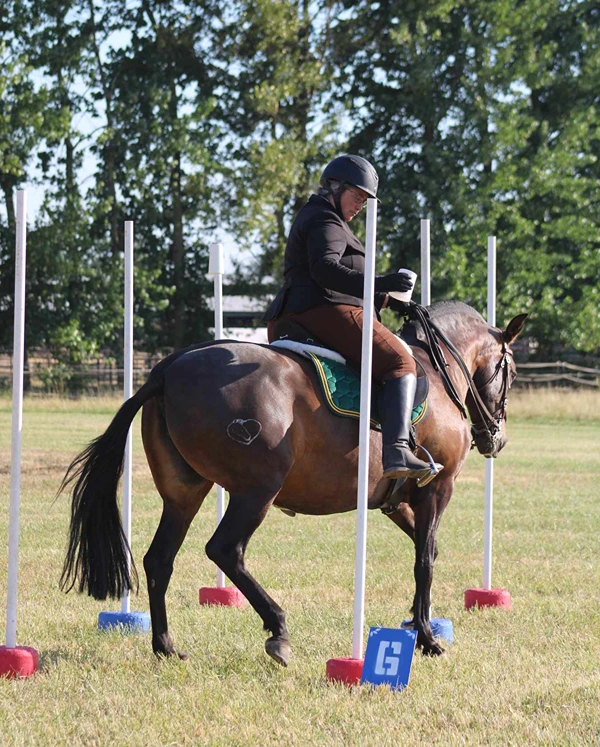
Photo courtesy of Diane Yin Chang’e
Rounding Posts is an obstacle that horses and riders may be required to navigate during the Ease of Handling and/or Speed trials. This obstacle can be used at all levels.
Description
Two parallel lines of three posts each create a 1.5-m (5-ft) wide corridor. The posts in each line are separated a minimum of 2.5 m (8 ft) and a maximum of 3 m (10 ft) from each other and are aligned with the posts on the other line. A cup is placed upside-down on the tip of each of the end posts in the corridor.
Execution
The rider advances through the corridor at the prescribed gait and halts between the end posts to pick up a cup. The rider then reins back in a reverse slalom around the middle post on the side of the corridor from which she/he removed the cup and deposits the cup on the tip of the post at the entrance of the corridor corresponding with the side from which the cup was retrieved.
The rider must keep the cup in her/his hand throughout the execution of the obstacle, but the obstacle can be completed with two hands on the reins if the rider is performing two-handed.
The horse must halt between the posts, showing immobility when the rider picks up the cup from the post.
To complete the obstacle, the horse must rein back fully to exit (i.e., all four feet) from the last pair of posts.
For the obstacle to be considered complete, the first two and the last two posts must be standing, and the cup must be placed correctly on the last post with the rider mounted.
For Introductory and Novice levels (L1–L3), the horse and rider rein back straight between the posts without performing a slalom.
If the cup is dropped, a member of the ground crew will hand the cup to the riders competing at the Introductory (L1) level.
Novice (L2/L3) riders must dismount, retrieve the cup, remount with the cup in hand, and replace it on the post or may request permission to pass and receive a 0 for the obstacle.
Intermediate (L4) through Masters (L7) riders must dismount, retrieve, remount, and place the cup or be disqualified.
If the rider knocks down one of the first two or last two posts, a member of the ground crew will reset the post for L1 riders.
L2/L3 riders have the option of dismounting, resetting the post, remounting, and replacing the cup, or requesting permission to pass and receive a 0 for the obstacle.
L4 through L7 riders must dismount, reset the post, remount, and place the cup on the post; failure to do so will result in disqualification.
Assessment Criteria (EOH)
The Judge should consider the quality of the gait and the halt transition. The Judge will evaluate the fluidity of the horse’s movements and its response to the use of the aids, enabling the obstacle to be performed with maximum smoothness and accuracy.
An entry at canter (or trot for L2/L3) is more valuable than an entry at walk.
A rider performing the obstacle with one hand may earn a higher mark.
The horse should remain immobile in the halt; failure to do so will result in a negative mark.
Touching any of the posts will result in a lower mark.
Knocking over a post will result in a negative mark.
Failure to replace the cup on the designated post will result in a disqualification.
The Judge will give a lower mark to a horse that drags its feet during the rein back.
Course Errors
• Exiting the destination end of the corridor with all four feet.
• L1–L3: Exiting the side of the obstacle with all four feet.
• L4–L7: Moving more than 3m (10 ft) away from the obstacle in the reverse slalom.
Serious Mistakes
• Touching or knocking down posts
• Resistance
• Poor quality of reinback (loss of diagonals)
• Lack of immobility at the halt
Single Slalom
Photo courtesy of Michael T. Photography
We attempt to keep the information on this website accurate and current. In the event of conflicting information, the information published in the most recent version of the United States Rules for Working Equitation, APPENDIX B. OBSTACLES will take precedence over the information provided on this website. To ensure you have the most up-to-date information, please refer to the current version of the Rulebook and its appendices before constructing obstacles and competing.
Photo courtesy of Katherine E.

The Single Slalom is an obstacle that horses and riders may be required to navigate during the Ease of Handling and/or Speed trials. This obstacle can be used at all levels and in both directions.
Description
This obstacle consists of an odd number of posts or similarly shaped objects in a straight line with bases not secured to the ground. There must be a minimum of five posts; seven are recommended for Advanced and Masters (L6/L7) levels. The posts are approximately 2 m (6.5 ft) in height and set with a distance of 6 m (20 ft) between each post. Flags indicating side of entry are placed on the appropriate side of the first post or can be placed on the post itself. Entry/exit markers are recommended for this obstacle.
Execution
The obstacle is entered in the prescribed gait. If there are not flags marking the exit of the obstacle, the obstacle is complete when the horse has broken the line between the two final posts.
The line of travel should be weaving through the posts rather than loops around the posts.
Lead changes must be performed as prescribed for that level.
Changes of bend and lead are to be executed at each change of direction, in the line and midway between the posts. The horse’s lead and bend should be in conformity with the turn.
Assessment Criteria (EOH)
The Judge will evaluate the horse’s calm, precise action; fluid and continuous movement; quality of gait; overall manner in performing this obstacle; and the quality of the lead changes.
The Judge should consider correctness and attitude during the change of lead and/or changes of bend through the horse’s body.
Riders using the same number of strides between the lead changes and/or changes of bend will receive a higher mark.
Late or delayed lead changes and/or changes of bend will result in a lower mark.
Failure to perform lead changes and/or changes of bend will result in a negative mark.
The shape, symmetry, and precision of the bending line, and the horse’s response to the rider’s aids will be considered.
A negative mark will be given for knocking down any of the posts.
Serious Mistakes
• Failure to perform (or mistakes in) flying lead changes or changes of bend
• Severe resistance
• Changes in rhythm
• Failure to keep a uniform and symmetrical bend
• Knocking down post(s)
Double Slalom
We attempt to keep the information on this website accurate and current. In the event of conflicting information, the information published in the most recent version of the United States Rules for Working Equitation, APPENDIX B. OBSTACLES will take precedence over the information provided on this website. To ensure you have the most up-to-date information, please refer to the current version of the Rulebook and its appendices before constructing obstacles and competing.


The Double Slalom is an obstacle that horses and riders may be required to navigate during the Ease of Handling and/or Speed trials. This obstacle can be used at all levels and in both directions.
Description
This obstacle consists of an odd number of upright posts: five for Intro (L1), Novice (L2/L3), and Intermediate (L4/L5) levels; seven for Advanced (L6) and Masters (L7) levels. Each post is approximately 2 m (6.5 ft) in height, with a base not secured to the ground. The posts are arranged in two staggered parallel lines, with a distance of 6 m (20 ft) between the parallel lines and between each post on the line. The posts are staggered such that the midpoint between the first two posts of the first line is directly opposite the first post of the second line. Entry/exit markers are recommended for this obstacle.
Execution
The obstacle is entered at the prescribed gait. The horse will perform half turns of consistent size around the posts in the direction indicated by the flags. The horse must go around the posts and follow a straight line until it starts the next half turn.
At lower levels (L3 and below), a larger loop may be needed to maintain correct impulsion and rhythm.
Changes of lead/bend are performed halfway between the posts and on the line between the successive posts.
The horse’s lead and bend should conform to the direction of the turn.
The number of strides between change of lead/bend should be constant throughout the obstacle.
If there are no exit markers, the obstacle is complete when the horse has crossed the line between the final two posts.
Assessment Criteria (EOH)
The Judge will evaluate the horse’s calm, precise action; quality of gait; fluid and continuous movement; overall manner in performing this obstacle; the straightness of the lines; and the quality of the lead changes or changes of bend and the number of strides between them.
The shape, symmetry, and precision of the turns for this obstacle, and the horse’s response to the rider’s aids will be considered.
The Judge should consider correctness and attitude during the change of lead and/or changes of bend through the horse’s body, and the horse’s bend around the posts.
A rider using the same number of strides between the flying changes should receive a higher mark.
Late or delayed lead changes or changes of bend will result in a lower mark.
Failure to perform lead changes and/or changes of bend will result in a negative mark.
A negative mark will be given for knocking down any of the posts.
Serious Mistakes
• Mistakes (more than one) in the flying changes
• Lack of symmetry in bending
• Knocking down posts
• Failure to maintain gait or rhythm
• Severe resistance
Gate
We attempt to keep the information on this website accurate and current. In the event of conflicting information, the information published in the most recent version of the United States Rules for Working Equitation, APPENDIX B. OBSTACLES will take precedence over the information provided on this website. To ensure you have the most up-to-date information, please refer to the current version of the Rulebook and its appendices before constructing obstacles and competing.
The Gate is an obstacle that horses and riders may be required to navigate during the Ease of Handling and/or Speed trials. This obstacle can be used at all levels and in both directions.
Description
The gate must be at least 1.3 m (4-ft 3-in.) high and 2-m (6.5-ft) wide, supported by two weighted posts (or jump standards) and two hinges.
A latch easily operated from horseback should be used.
The gate can be opened to the right or left depending on how the obstacle is set in the course.
A rope between two posts can be used instead of a solid gate.
A solid gate is preferred for Ease of Handling in licensed shows and is required in championship competitions.
A rope gate should be used for Speed.
Execution
The rider should approach perpendicular to the gate at the prescribed gait for the level, transition to the walk 3 to 5 meters (10 to 16 ft) from the gate, and then turn the horse and halt alongside the gate.
The rider must lift the latch, open the gate, and go through the entrance.
When the horse has fully passed to the other side of the gate, the rider may back up one or two steps to close the gate.
With the horse squarely halted, the rider will then put the latch in place to complete the obstacle.
The rider should not release control of the gate at any point in the performance of this exercise until the gate is latched.
The obstacle may be required in both directions providing there is at least one obstacle in between the first and second execution.
Assessment Criteria (EOH)
The Judge will evaluate the manner and direction (90 degrees from the gate) of the transition to the walk and the horse’s action, which should be fluid and without any hesitation. The horse should pay attention to and participate in the opening and closing movements without showing any signs of insecurity or disobedience. The rider’s action should be easy, precise, and free from hesitation.
A negative mark will be given if the rider releases control of the gate by letting go for more than a momentary adjustment of hand position at any time during the execution of this obstacle, or if there is any sign of insecurity by the horse or rider or lack of continuity (fluidity) of the action.
Switching hands will result in a disqualification.
Passing the rope over the head of the rider when using a rope gate will result in a disqualification.
Serious Mistakes
• Making the transition without the horse being perpendicular to the gate
• Hesitation, tension, or pulling back when approaching the gate
• Resistance in transitions and passing through the gate
• Destroying or knocking down any part of the obstacle
• Letting go of the gate or latch
Jump
We attempt to keep the information on this website accurate and current. In the event of conflicting information, the information published in the most recent version of the United States Rules for Working Equitation, APPENDIX B. OBSTACLES will take precedence over the information provided on this website. To ensure you have the most up-to-date information, please refer to the current version of the Rulebook and its appendices before constructing obstacles and competing.
The Jump is an obstacle that horses and riders may be required to navigate during the Ease of Handling and/or Speed trials. This obstacle can be used at all levels and in both directions.
Description
The obstacle consists of a single jump in a progression of heights for each level. Standard jump rails or a solid wood obstacle (like a flower box) can be used. Bales of straw placed end-to-end are acceptable.
The jump must be at least 3-m (10-ft) across.
The jump must be positioned between two jump standards with appropriate jump cups.
L1: Jump consists of a pair of crossed rails not to exceed 0.3 m (12 in.) at the center.
L2 and L3: Jump consists of a pair of crossed rails not to exceed 0.5 m (22 in.) at the standard and 0.4 m (15 in.) at the center.
L4 thru L7: Jump consists of a solid-looking obstacle or rails set 0.5-m (22-in.) high with a ground pole placed under the jump.
Execution
The horse should approach and jump over the obstacle cleanly, naturally, and with assurance.
The obstacle may be required in both directions providing there is at least one obstacle in between the first and second execution.
Assessment Criteria (EOH)
The Judge will evaluate:
• The manner in which the horse approaches and leaves the obstacle;
• The horse’s calmness, straightness, and tempo throughout the obstacle;
• The quality of the gait in the approach to the jump and the exit;
• The lead in which the horse canters before and after the jump (L2-L7);
• The bascule over the jump;
• The rider’s balance, position, and use of aids in performing the obstacle; and
• The pair’s confidence and style.
For L1, a break in gait will result in a lower mark. Walking the obstacle can earn a mark no higher than 7.
Knocking over any part of the obstacle will result in a negative mark.
Serious Mistakes
• Refusal to jump
• Incorrect style (e.g., too tense, too flat, no bascule, over jumping, etc.)
• Lacking impulsion and willingness
• Knocking over any part of the obstacle
• Severe resistance
• Rider interference with the horse’s mouth or back during the jump or landing
Sidepass Rail
Photo courtesy of Kurtz
We attempt to keep the information on this website accurate and current. In the event of conflicting information, the information published in the most recent version of the United States Rules for Working Equitation, APPENDIX B. OBSTACLES will take precedence over the information provided on this website. To ensure you have the most up-to-date information, please refer to the current version of the Rulebook and its appendices before constructing obstacles and competing.
The Sidepass Rail is an obstacle that horses and riders may be required to navigate during the Ease of Handling and/or Speed trials. This obstacle is not used at the Introductory level.
Description
This obstacle consists of one to three rails about 3 m (12 ft) in length with a diameter of not more than 10 cm (4 in.), supported 5-10 cm (2-4 in.) above the ground.
The rails may be arranged in the following configurations:
(1) Single rail
(2) Two rails in a line separated by at least 3 m (10 ft)
(3) Two parallel rails separated by at least 3 m (10 ft)
(4) Two rails in an “L” configuration
Entry/exit markers are required for this obstacle. The markers indicate the start and end of the obstacle, not the transition.
Execution
The horse must approach parallel to the first rail and transition to nearly perpendicular to the rail before beginning the obstacle.
The rail must be kept between the horse’s front and hind legs throughout the obstacle.
If performed at the walk, the horse’s legs must cross while going over the rail.
At Level 4 and above, the horse’s body is bent in the direction of travel; for the Novice levels (L2/L3), the horse’s body can be bent away from the direction of travel.
The course map may indicate which direction (right or left) the horse and rider must pass over the rail; when not specified, the rider chooses the direction.
For the two rails in a line (2) and the parallel rail (3) configurations, the rails must be ridden in different directions.
Entry and exit markers mark the start and end of the obstacle, not the transition.
This obstacle is not used for Introductory (L1) riders.
Assessment Criteria (EOH)
The Judge will evaluate the horse’s calmness, capacity to perform the obstacle, crossing of the legs, and the fluidity and continuity of the action.
For L6 and L7, a higher mark will be given for performing the obstacle at canter than at walk.
A lower mark will be given for bumping the rail.
The Judge will give a lower mark for a lack of crossing of the horse’s legs in the lateral movement.
A negative mark will be given for knocking over the rail or if the horse steps across the rail with one or more feet.
Exiting the rail prematurely or failing to sidestep over the entire length of the rail is a course error.
Serious Mistakes
• Failure to cross legs (if done in walk)
• Knocking over the rail
• Severe resistance
• Not performing the obstacle bent in the direction of travel (L4 and above)
Water
We attempt to keep the information on this website accurate and current. In the event of conflicting information, the information published in the most recent version of the United States Rules for Working Equitation, APPENDIX B. OBSTACLES will take precedence over the information provided on this website. To ensure you have the most up-to-date information, please refer to the current version of the Rulebook and its appendices before constructing obstacles and competing.
Speed Trial
Ease of Handling (EOH) Trial
Water is an obstacle that horses and riders may be required to navigate during the Ease of Handling and/or Speed trials. This obstacle can be used at all levels and in both directions.
Description
The ditch should be a minimum of 1.5 m (5 ft) in the direction of travel (long), and a minimum of 2.4 m (8 ft) wide.
The ditch may be flat with a minimum depth of 10 cm (4 in.) or gently sloping to a maximum depth of 20 cm (8 in.).
The bottom surface should be safe for horses to travel across.
Course markers may be used to mark the entrance and exit.
The obstacle may be framed with logs so horses have to step over and into/out of the water.
Execution
The horse should approach and maintain gait through the water naturally and without any hesitation.
The obstacle is performed at the walk in Ease of Handling.
Assessment Criteria (EOH)
The Judge will evaluate the manner in which the horse approaches the ditch, its reaction when going through the water, and the consistency of gait throughout the exercise.
A lower mark will be given for hesitancy by the horse.
A negative mark will be given if the horse steps backward before riding through the ditch or jumps the ditch without going through the water.
Bank
We attempt to keep the information on this website accurate and current. In the event of conflicting information, the information published in the most recent version of the United States Rules for Working Equitation, APPENDIX B. OBSTACLES will take precedence over the information provided on this website. To ensure you have the most up-to-date information, please refer to the current version of the Rulebook and its appendices before constructing obstacles and competing.
The Bank is an obstacle that horses and riders may be required to navigate during the Ease of Handling and/or Speed trials. This obstacle is not used at the Introductory level.
Description
The obstacle consists of an embankment of natural substance positioned not more than 30 to 60 cm (1 to 2 ft) above ground level.
A level plateau is at the top and bottom of the embankment; the plateau must be at least 2-m (6.5-ft) long in the direction of travel.
There may be ramps leading to and away from the level plateaus.
Execution
The horse should approach and maintain the chosen gait through the obstacle naturally and without any hesitation.
The obstacle can be executed as either an up-bank or a down-bank.
Both an up-bank and a down-bank may be incorporated and scored as one obstacle.
This obstacle is not used for Introductory (L1) riders.
Assessment Criteria (EOH)
The Judge will evaluate the manner in which the horse approaches the bank, the smoothness of the execution, the consistency and quality of gait throughout the exercise, and confidence in the rider’s instructions.
Lower marks are awarded for hesitancy.
A horse that steps backward before going over the bank or steps off the side of the bank will receive a negative mark.
Drums
We attempt to keep the information on this website accurate and current. In the event of conflicting information, the information published in the most recent version of the United States Rules for Working Equitation, APPENDIX B. OBSTACLES will take precedence over the information provided on this website. To ensure you have the most up-to-date information, please refer to the current version of the Rulebook and its appendices before constructing obstacles and competing.
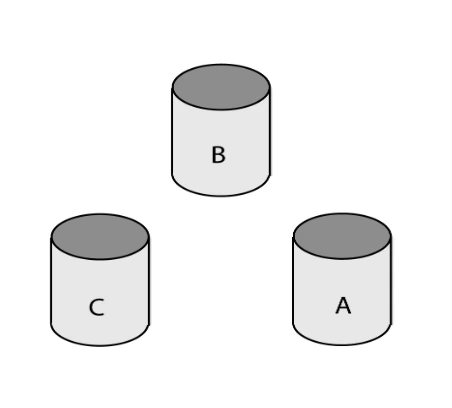
The Drums is an obstacle that horses and riders may be required to navigate during the Ease of Handling and/or Speed trials. This obstacle can be used at all levels and in both directions.
Some people call this obstacle the “cloverleaf,” which describes the pattern required at the obstacle; however it is not the same as a barrel racer’s pattern.
Description
This obstacle consists of three drums positioned at the three points of an equilateral triangle with sides 3- to 4-m (10- to 13-ft) long, measured from the center of the drums. The drums are set 4-m (13-ft) apart for Introductory (L1), Novice (L2/L3), and Intermediate (L4/L5) levels, and 3-m (10-ft) apart for Advanced (L6) and Masters (L7) levels.
Execution
The horse enters at the appropriate gait for the level between drums A & C. The horse makes a full circle to the right around drum A. The horse proceeds to pass halfway between drums A & B, with a change of lead and/or bend over the imaginary line between A & B. The horse makes a loop to the left around drum B. The horse then proceeds to pass halfway between drums B & C, with a change of lead and/or bend along the imaginary line between B & C. The horse makes a full circle to the right around drum C and exits at the same point from which the exercise began. All circles should be symmetrical and of the same diameter. The goal of this obstacle is to exhibit ease of handling and the capacity to perform in tight turns while also maintaining the impulsion and tempo of the gait.
Assessment Criteria (EOH)
The Judge will consider the horse’s attitude, the rider’s use of aids, tempo, continuity of action, quality of gait, fluidity of performance, correctness and attitude during the change of lead, accuracy of the passage halfway between the drums, and the shape, symmetry, and precision of the circles. The highest degree of execution is a 4-m circle for Introductory through Intermediate levels, and a 3-m circle for Advanced and Masters levels. A lower mark will be given for incorrect placement of change of lead and/or change of bend (failure to perform midway between the drums). A negative mark will be given for failure to perform a change of lead and/or change of bend. The Judge will give a negative mark if a drum is knocked over.
Serious Mistakes
• Location of the flying changes and/or bend
• Lack of symmetry in the size of the circles
• Mistakes in bending
• Break in gait
• Circles too large (L6/L7)
• Knocking over a drum
